Tires are the only point of contact with the ground, making all the difference between breaking your personal record or just breaking your nose. This makes choosing the right gravel tires vital, but the options are as varied as gravel riding itself. We compared the most exciting models, and we’ll tell you what to look for.
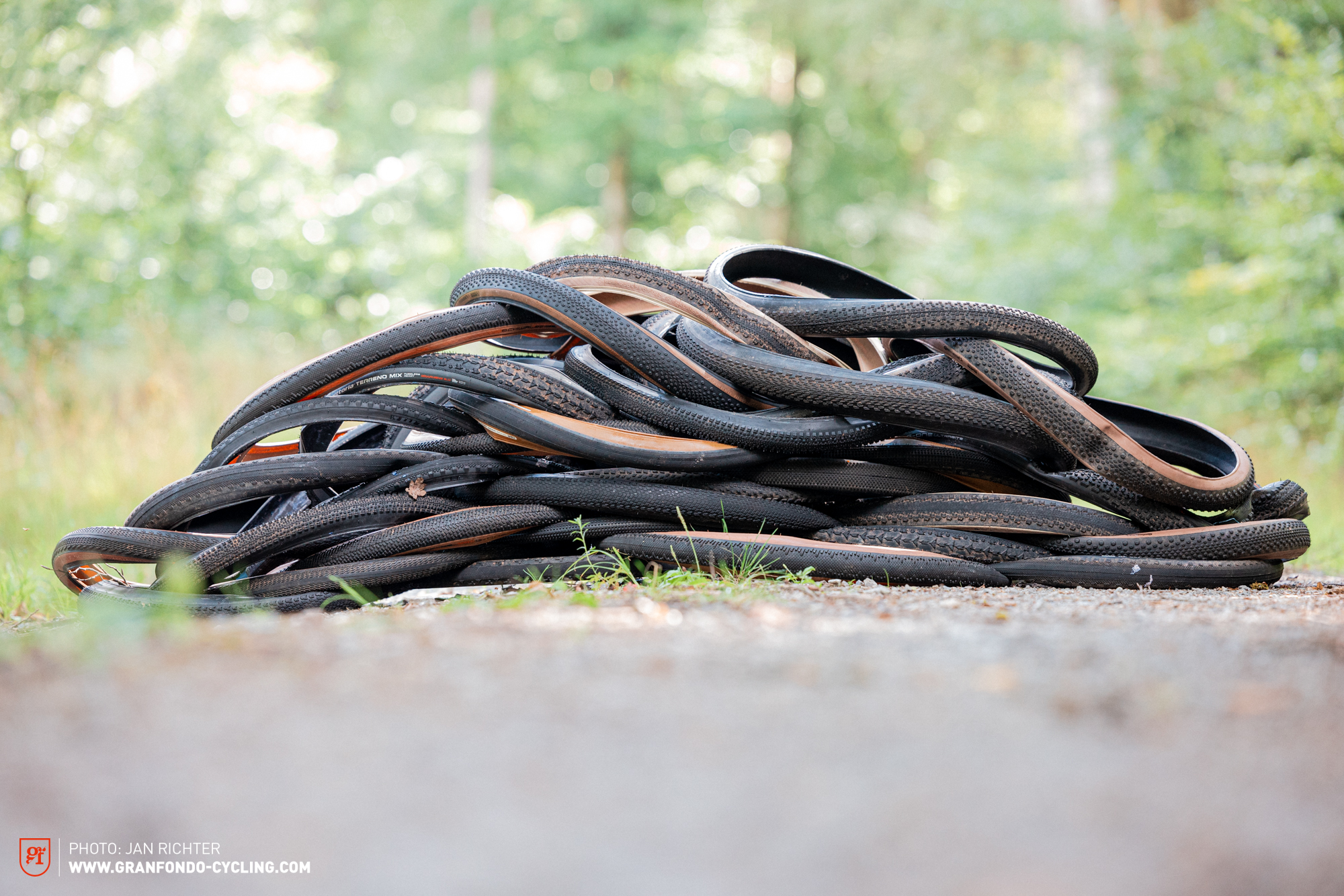
Inhaltsverzeichnis
- Why is choosing the right gravel tires so important?
- The test field of our 2023 gravel tire group test
- The requirements of gravel tires
- What to consider when choosing the right gravel tires
- Who tested, and how?
- The highlights of our big 2023 gravel tire group test
- Insights – How do you get the most out of your tires?
- Conclusion
The world of gravel bikes is alive and constantly evolving. Gravel racing with super-fast, aerodynamically optimised bikes is no longer a rarity. And we’re increasingly seeing trends from the road segment being adopted by gravel riders. At the other end of the gravel spectrum, the bikes are becoming more and more like mountain bikes – with suspension forks, dropper posts, and mullet drivetrains almost commonplace. Bikes like the Specialized Diverge STR even feature rear suspension. Other models such as YT SZEPTER and Mondraker Dusty have been specially developed for off-road use. Between these two extremes, however, gravel bikes still remain the go-to choice for many adventure seekers and commuters.
So it’s clear that not all gravel is the same. This also applies to the tires. Different use cases, surfaces, and preferences make the requirements for gravel tires so diverse that a conventional tire group test with a single test winner wouldn’t suffice. Therefore, we didn’t want to have just one recommended pick. Instead, we’ll give you the tools to find the perfect gravel tires for you. We reviewed 20 of the most exciting gravel tires and subjected them to the ultimate test in an elaborate laboratory setup, and on our very own test track.
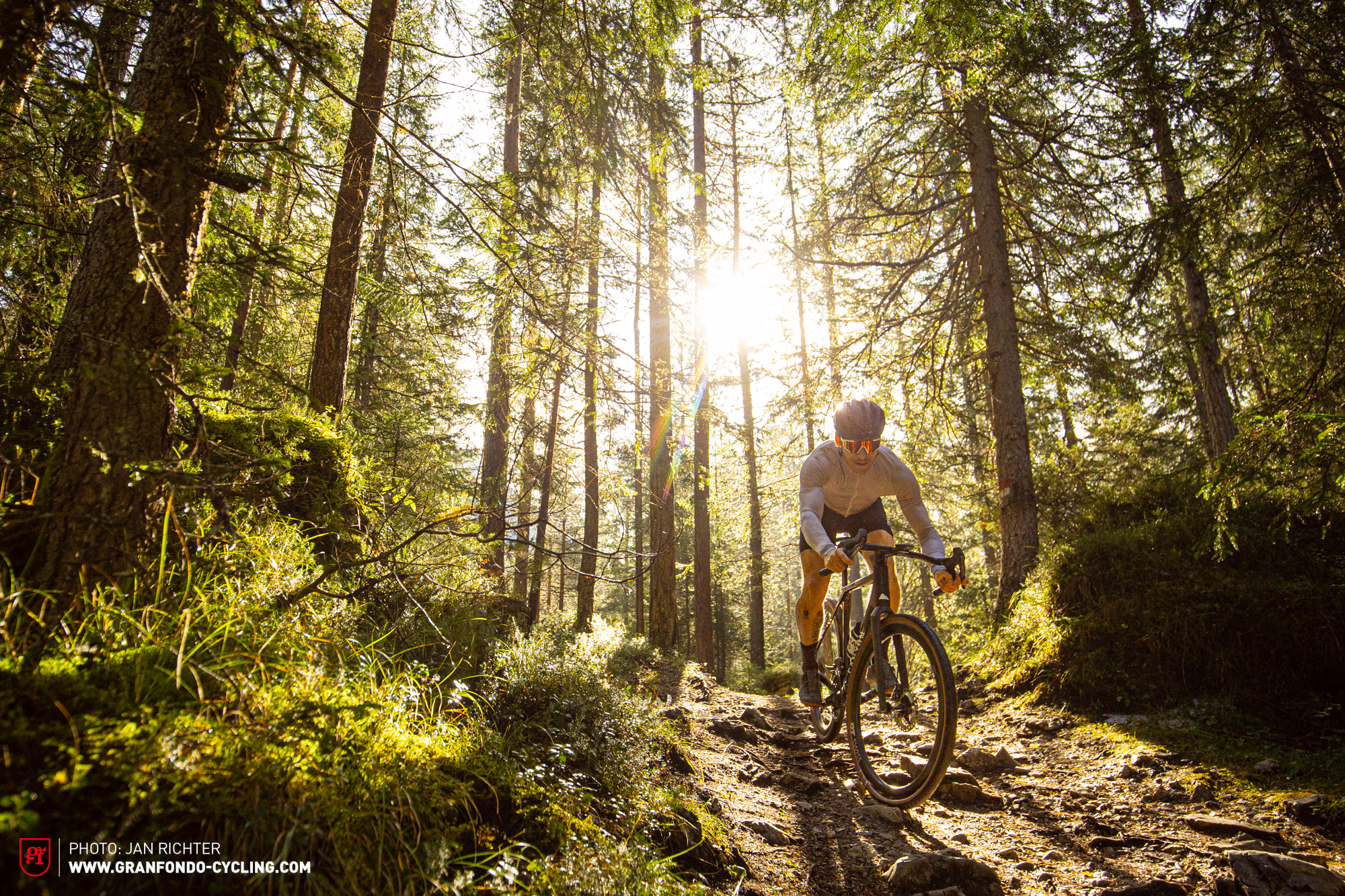
Why is choosing the right gravel tires so important?
Gravel tires are unique. They can’t be classified as knobby mountain bike tires, nor are they anything like classic road bike tires. They’re somewhere in between, catering to unique demands and having their own characteristic features. There is a wide variety of tire dimensions, treads, and even rubber compounds.
In this colourful world of gravel, there’s not one perfect do-it-all set of tires for everyone, but every type of rider will find their perfect tires. The gravel segment is extremely diverse, and choosing the right tires depends on a few crucial factors, which need to be weighted differently depending on your needs.
Traction – Traction plays a crucial role. It’s not just important on the trail, but can also decide between setting a new record or sampling the ground. Having the right tread pattern that’s suitable for the terrain ensures optimum traction.
Breaking distance – The later you brake, the faster you’ll be. However, this is a skill you need to practise. That said, the more grip your tires provide, the quicker you can stop. This can increase your confidence enormously, especially on unfamiliar gravel descents.
Rolling resistance – Long day in the saddle or racing against the clock? Efficient tires can save valuable watts. Besides the tread pattern, the rubber compound and, above all, the tire pressure also play a role in this.
Puncture protection – Patching, pumping, or having a beer? Puncture protection prevents involuntary stops in rough terrain, so you can keep going for longer.
While these facts aren’t everything, because cycling is primarily about experiencing emotions, the tires shouldn’t slow you down! And since the use cases and riders are as individual as the tires themselves, we’ve conducted this tire group test for all gravel enthusiasts: for those with a need for speed and KOMs; for those who plan long route and are in search of adventure; and, of course, for those who just want to have fun.
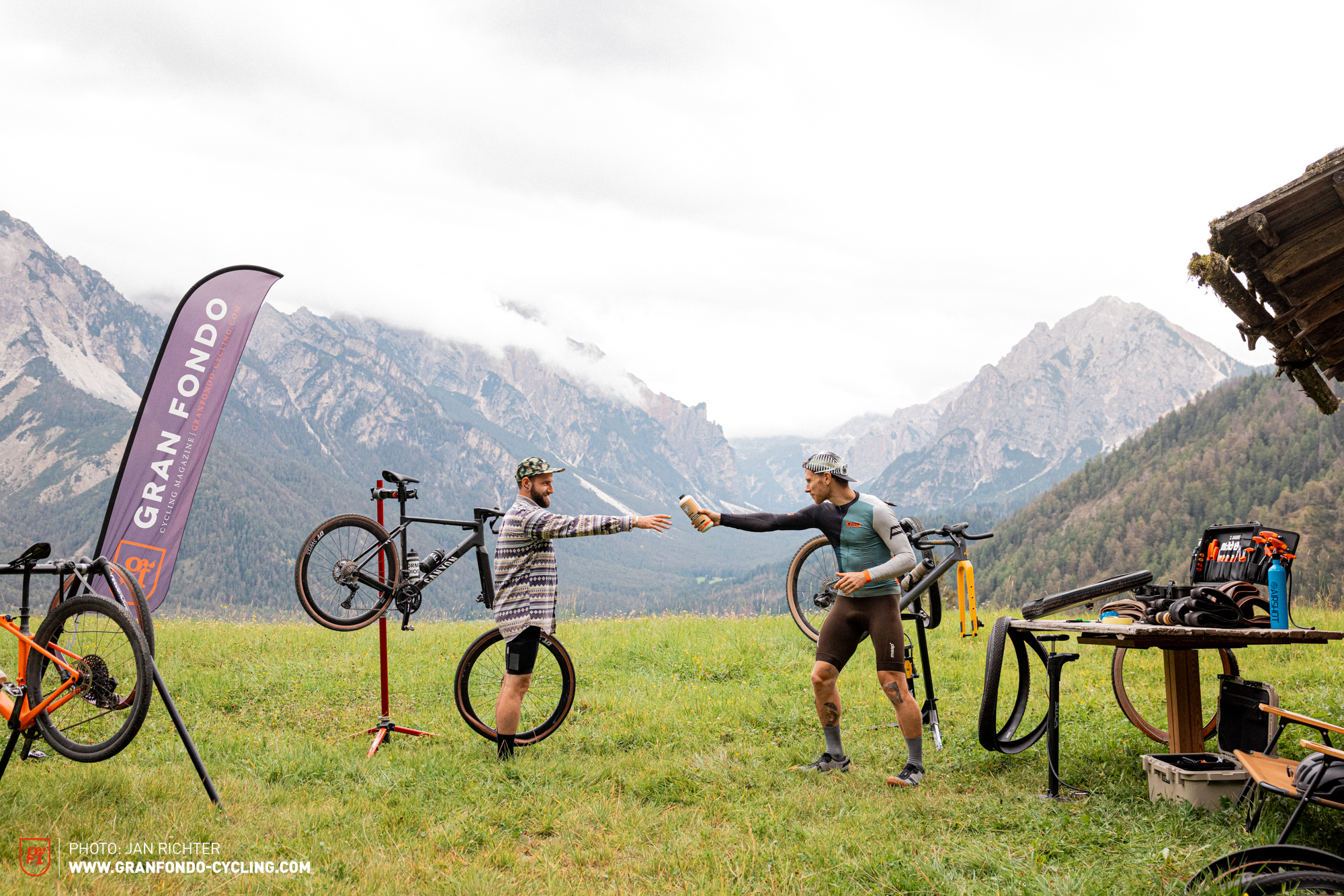
The test field of our 2023 gravel tire group test
A meaningful tire test needs the right test field. The question is, what characterises gravel today, and what does the future hold? Gravel tires must be tubeless – there’s no place for tubes in gravel riding. Tubeless and wide tires allow you to run lower pressures, they offer more comfort, traction, greater efficiency, and improved puncture protection. TPU tubes can keep up in terms of efficiency, but a tubeless setup outperforms them in all other respects. The gravel future is tubeless!
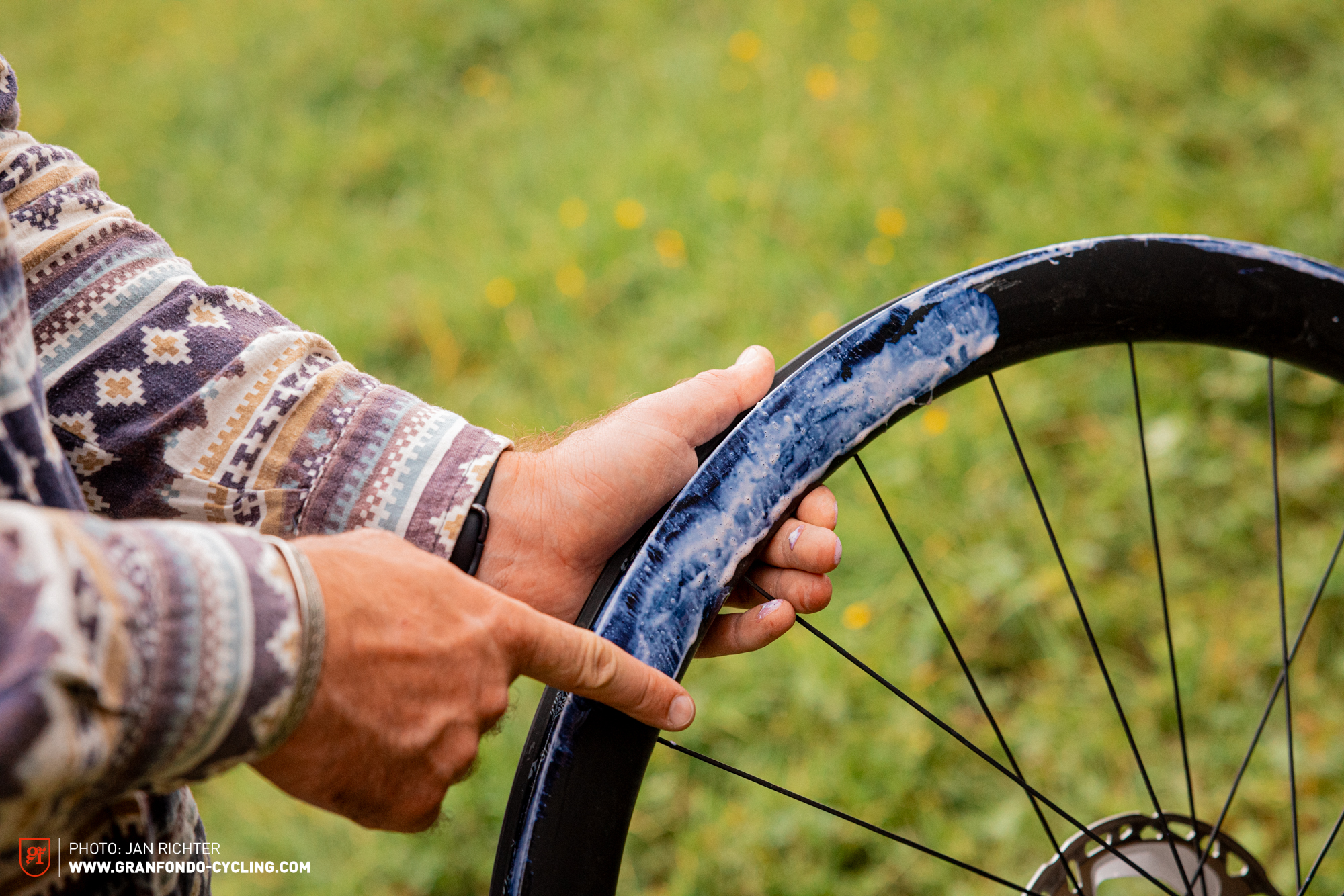
700c is the norm. Initial experiments with 650b and fat MTB tires have given way to the occasional gravel bike with 29″ tires. But we now have enough gravel specific 700c tires on the market that there’s no reason to rely on MTB sizes. For the sake of comparability, all the tires on test are 40 mm wide, or whatever width is closest to it if the tire in question is not available in 40 mm.
40 mm wide tires are the perfect compromise between a wide off-road and a skinny race setup. Depending on the intended use, however, it’s up to you to choose the most appropriate width.
Our group test covers all gravel categories, including the fastest and the grippiest tires, the best puncture protection, and the craziest tread pattern. All relevant tires models and brands are represented in our in-depth look at 20 tires from 9 brands in the laboratory. For our real-world tests, we rode the tires on a demanding test track through the Black Forest in all kinds of conditions, from dry to drenched. We pushed the tires to their limits, resulting in the occasional tubeless disaster, and became professionals in tire repairs and replacements in the process.

| Tire | Size | Tire width in mm¹ | Tire height in mm¹ | Tire height + rim height in mm² | Weight | Price |
|---|---|---|---|---|---|---|
| Challenge Getaway | 40–622 | 40 | 36.32 | 81.64 | 462.7 g | € 79.81 |
| Challenge Gravel Grinder | 40-622 | 39.5 | 35.55 | 80.87 | 452 g | € 79.81 |
| Continental Terra Speed | 40-622 | 38.4 | 34.35 | 79.67 | 492.5 g | € 65.95 |
| Continental Terra Trail | 40-622 | 39.6 | 34.91 | 80.23 | 436.1 g | € 65.95 |
| MAXXIS Rambler | 38-622 | 37.7 | 34.68 | 80 | 456.3 g | € 59.90 |
| MAXXIS Receptor | 40-622 | 40,25 | 35.91 | 81.23 | 425.4 g | € 59.90 |
| Panaracer GravelKing+ | 40-622 | 36.8 | 31.33 | 76.65 | 374.7 g | € 59.95 |
| Panaracer GravelKing SK+ | 43-622 | 42.4 | 36.67 | 81.99 | 542.2 g | € 59.90 |
| Pirelli Cinturato Gravel H | 42-622 | 40.75 | 37.32 | 82.64 | 490.3 g | € 69.90 |
| Pirelli Cinturato Gravel RC | 37-622 | 41.1 | 34.98 | 80.3 | 532.2 g | € 74.90 |
| Schwalbe G-One Allround Evo, Super Ground, TLE | 40-622 | 38.3 | 34 | 79.32 | 522.7 g | € 64.90 |
| Schwalbe G-One R Evo, Super Race, V-Guard, TLE | 40-622 | 39.8 | 34.73 | 80.05 | 499.7 g | € 74.90 |
| Schwalbe G-One RS Evo, Super Race, V-Guard, TLE | 40-622 | 40.5 | 35.05 | 80.37 | 482.9 g | € 74.90 |
| Schwalbe G-One Ultrabite Evo, Super Ground, TLE | 40-622 | 40.6 | 36.42 | 81.74 | 551 g | € 64.90 |
| Specialized S-Works Pathfinder | 42-622 | 42.69 | 39.33 | 84.65 | 445.3 g | € 60.00 |
| Specialized Tracer Pro | 42-622 | 42.5 | 39.34 | 84.66 | 542.5 g | € 50.00 |
| Vittoria Terreno Dry Gravel | 40-622 | 40.7 | 37.77 | 83.09 | 459.6 g | € 54.95 |
| Vittoria Terreno Mix | 40-622 | 40.4 | 38.28 | 83.6 | 503.6 g | € 54.95 |
| WTB Byway | 40/36 | 36.2 | 32.10 | 77.42 | 476.8 g | € 54.95 |
| WTB Riddler | 37-622 | 37.15 | 33.28 | 78.6 | 470.6 g | € 54.95 |
*1 measured at 2.5 bar
*2 test rim: ZIPP 303s 622 x 20.3C (rim height 45,32 mm)
The requirements of gravel tires
Choosing the right tires doesn’t start in the shop or on the internet, but at home and on the bike. There are some pivotal questions that only you can answer, determining your own requirements, and thus the perfect tire choice.
What must your tires be capable of? Where and how do you ride your bike, and where should it perform particularly well? Be realistic when answering these questions! Wishful thinking can be fun, but it certainly doesn’t help you find the perfect gravel tires. Besides your personal requirements, there are a few boxes that all tires should tick. Good looks, puncture protection, and easy installation simply make riding your bike more fun and provide longer-lasting enjoyment.

Speed
How fast do you ride and how important is speed to you? This determines how efficient the tires should be. Efficient tires roll faster, save power at constant speed, and make accelerating easier. This is usually achieved by a faster rolling, less aggressive tread, and a harder rubber compound. As a result, however, the tires don’t offer as much traction on loose and damp surfaces. Because gravel riding doesn’t take place on uniform terrain, the fastest gravel tire on asphalt won’t necessarily be the best on gravel. Therefore, pure rolling speed isn’t everything: Grip and compliance can also be decisive in gravel racing. But even if speed isn’t your number one goal, rolling efficiency shouldn’t be underestimated. In our test field, we found a difference of 10.6 watts between the fastest and the slowest model. So, with the right set of tires, you can save up to 21.2 watts.
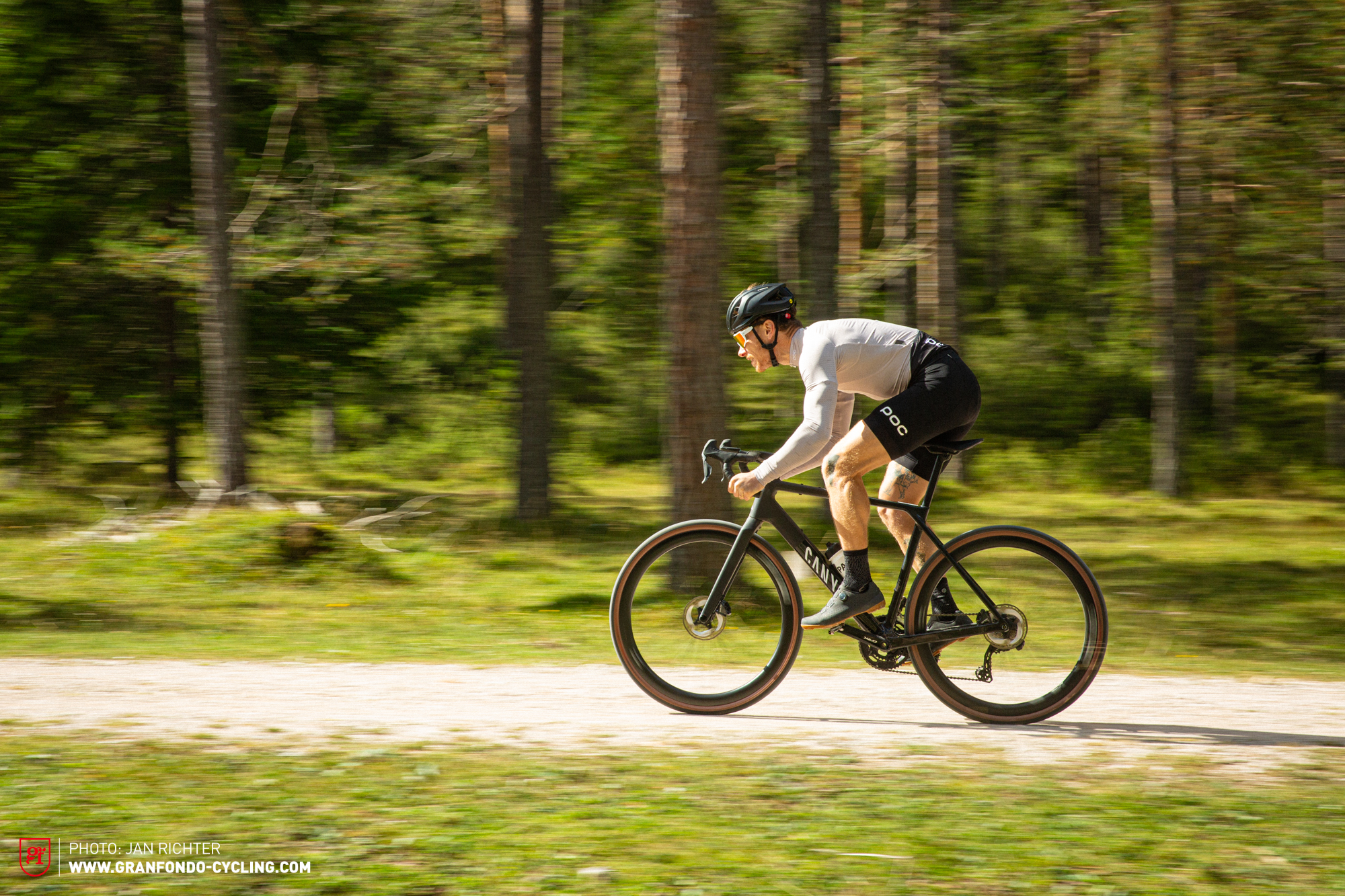
Comfort
How important is riding comfort to you? A lot of gravel bikes leave it solely up to the tires to generate comfort and compliance. However, this shouldn’t be the tires’ primary task – the frame itself, or damping elements can generate comfort without any unwanted side effects. That said, if the tires are the only way you can achieve more comfort and vibration damping affordably, the wider the tires, the lower you can run the tire pressures, the more comfort the tires will offer. However, this usually comes at the cost of efficiency, so you must choose the width and tire pressure carefully.
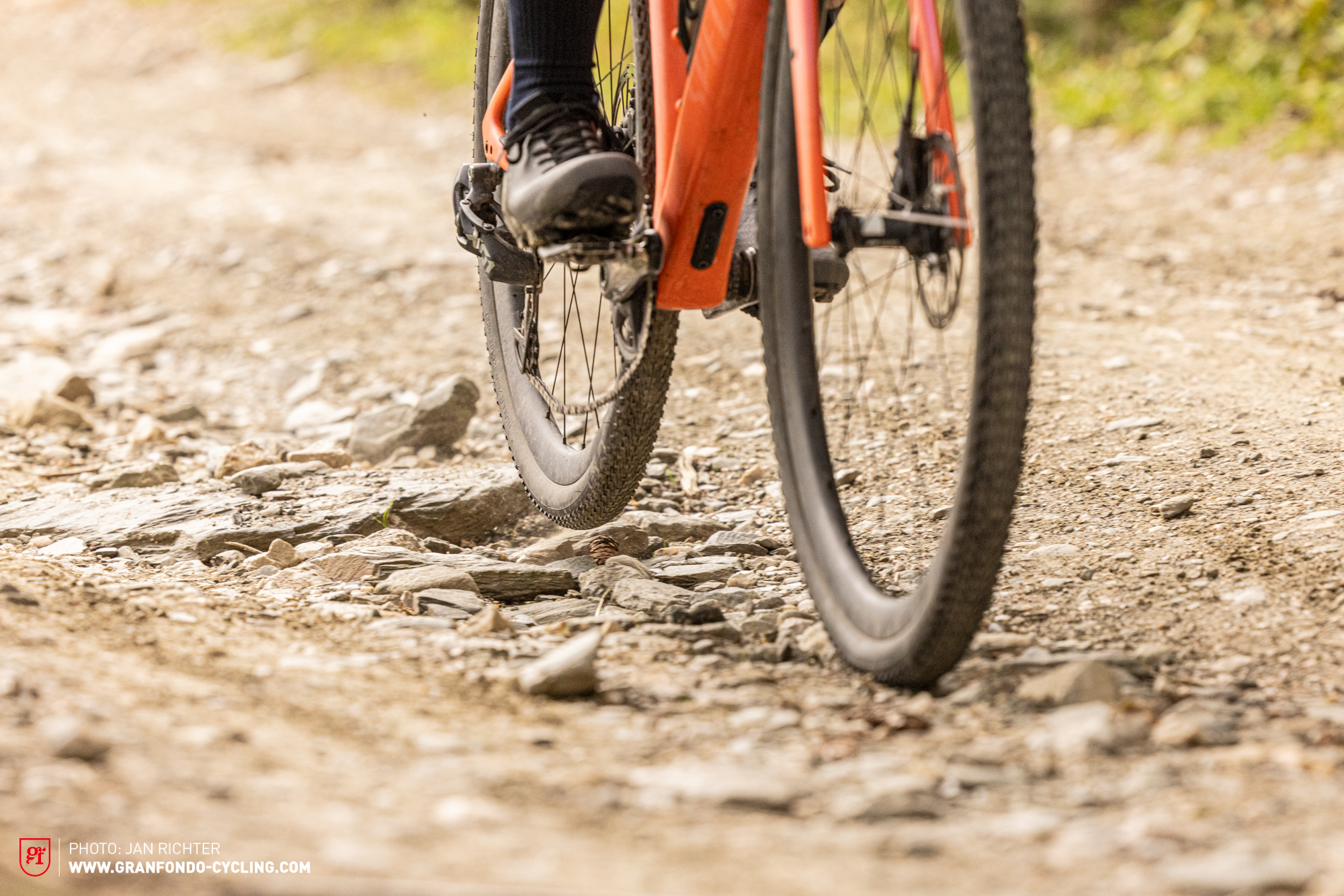
Traction / terrain
What kind of gravel do you prefer? On which terrain do you ride and, above all, where should the bike perform really well? Is the road leading to the woods just a means to an end, or is it part of the experience? And is real gravel even part of your usual gravel route? Depending on where you ride, the requirements of the tread change, and it is important to choose wisely here. Unlike MTB or road tires, gravel tires must perform well on a variety of surfaces. There are all-rounders that perform relatively well everywhere, and then there are specialists that excel in a specific type of terrain, but often only there.
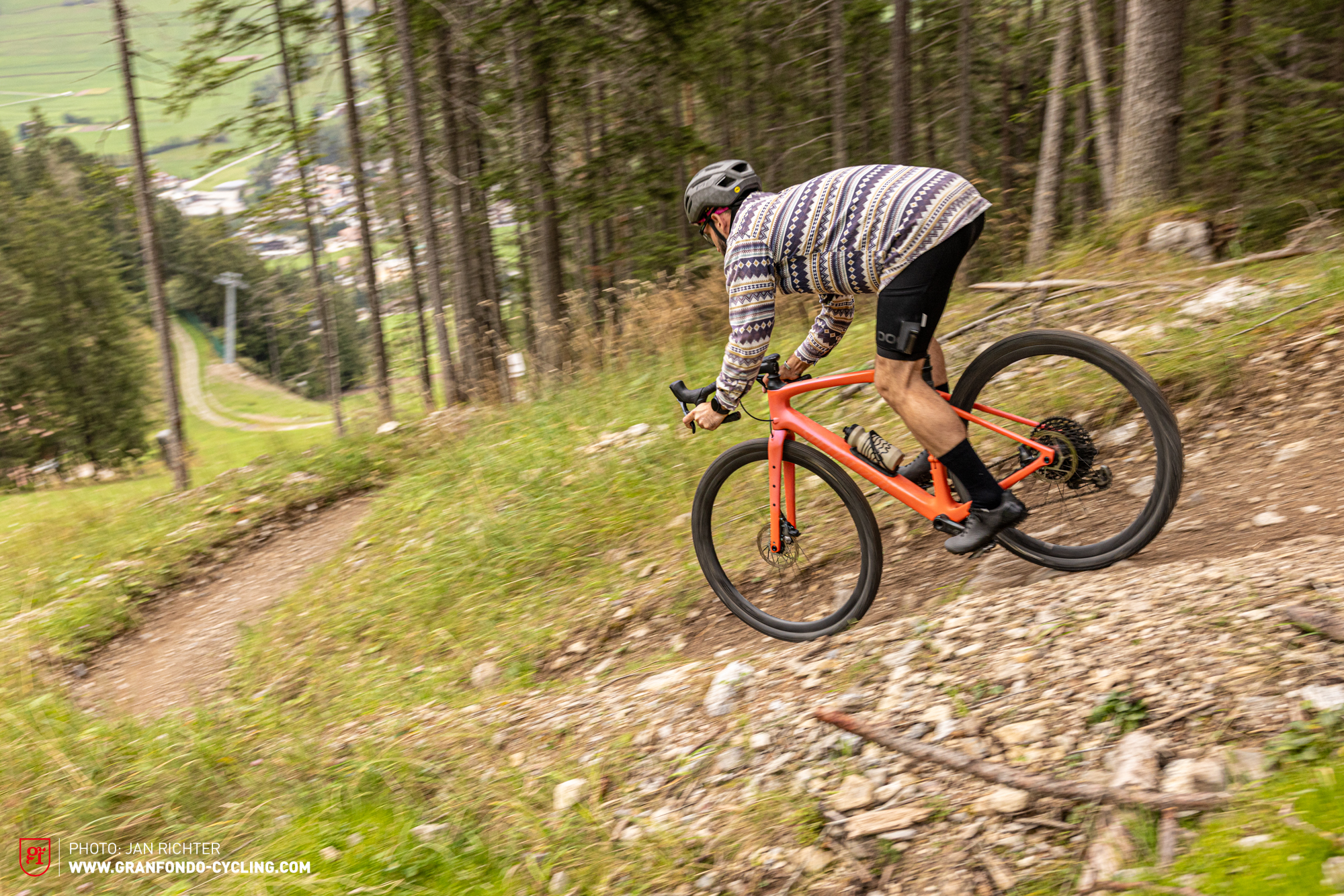
Puncture protection
How important is puncture protection to you? Sure, nobody likes mending tires, but puncture-proof tires are usually heavier and less efficient due to the use of thicker casings. This often makes puncture protection less relevant for efficiency-oriented riders, but even if a fast rolling tire can save you a few seconds, a flat tire can cost minutes. At the same time, you must also think about what the tires will have to deal with: sharp rocks and gravel, or poorly maintained cycle paths strewn with shards of glass? Some tires are specially designed for puncture protection, and off-road-oriented tires typically offer more protection, simply because of the deeper tread. Puncture protection also includes the reliability of the tire. Beautiful, fast, and handmade open-tubular tires are cool and set the bike apart, but what’s the point if you need to reinflate them every 200 km?

Ride feel
Ride feel is probably one of the simplest and often underestimated traits. Even if it only emerges during real world tests, there are some clues in the design. The transition between shoulder knobs and central tread is particularly important. A smooth centre tread and big shoulder knobs, like on the Schwalbe G-One RS or Vittoria Terreno Dry, combine efficient rolling with plenty of cornering grip. As a result, the tire often has a more square profile, which can lead to less agile handling, and a noticeable transition when leaning the bike over into a corner. Rounder tires with a uniform tread pattern are often easier to lean into a corner and offer consistent grip. The shape of the tire ultimately depends not just on the tread pattern, but also on the rim width in relation to the tire.
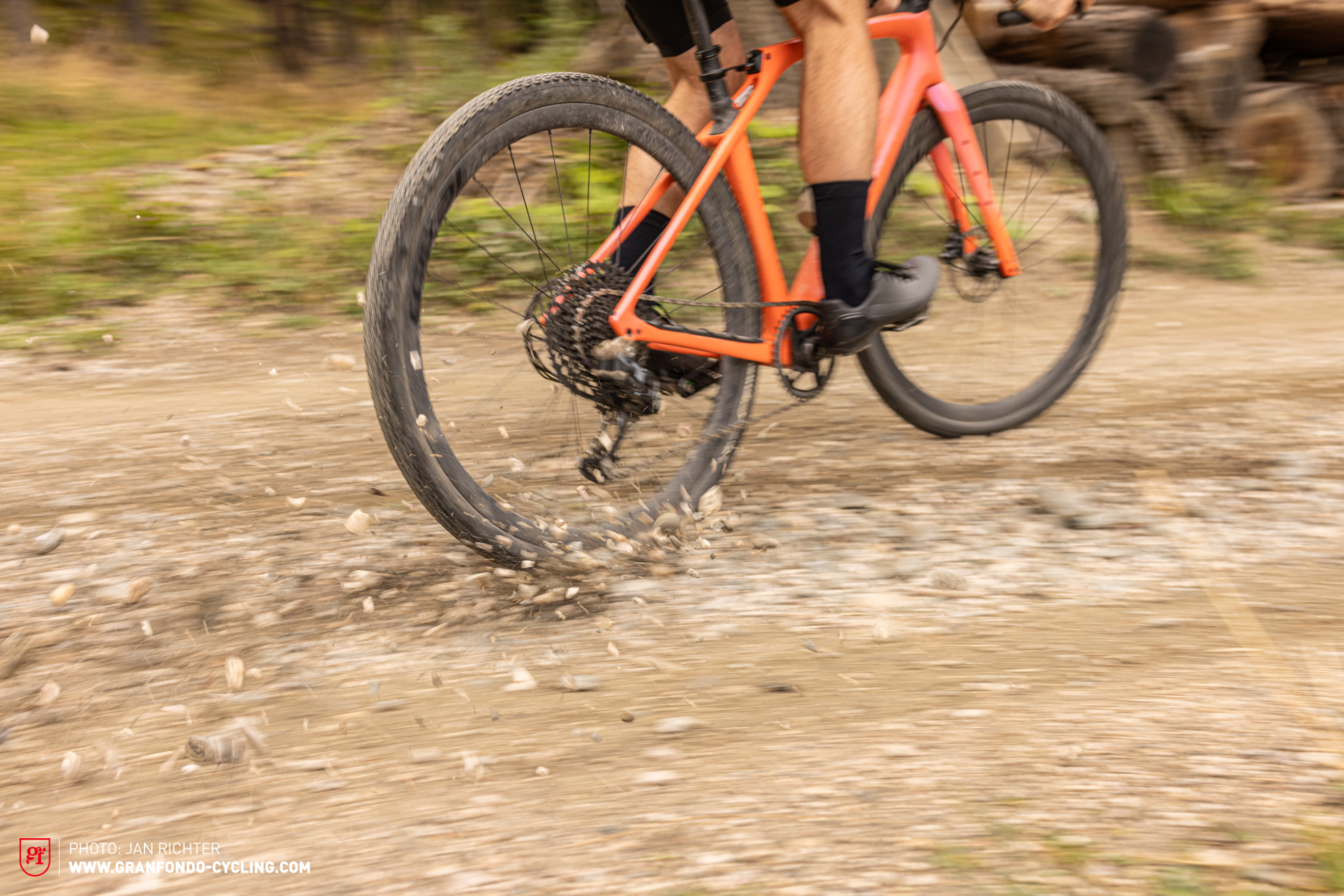
Price
Finally, the price also matters. Tires are subject to wear and tear, and must be replaced regularly. Are the most expensive tires worth their price? How much money do you want to spend on tires? And how much do you want to experiment with tires? Tires are amongst the most important components on a bike and have a direct influence on performance, so there are few bike components that can make such a big difference, whether negative or positive. So keep your eyes open when choosing your tires!
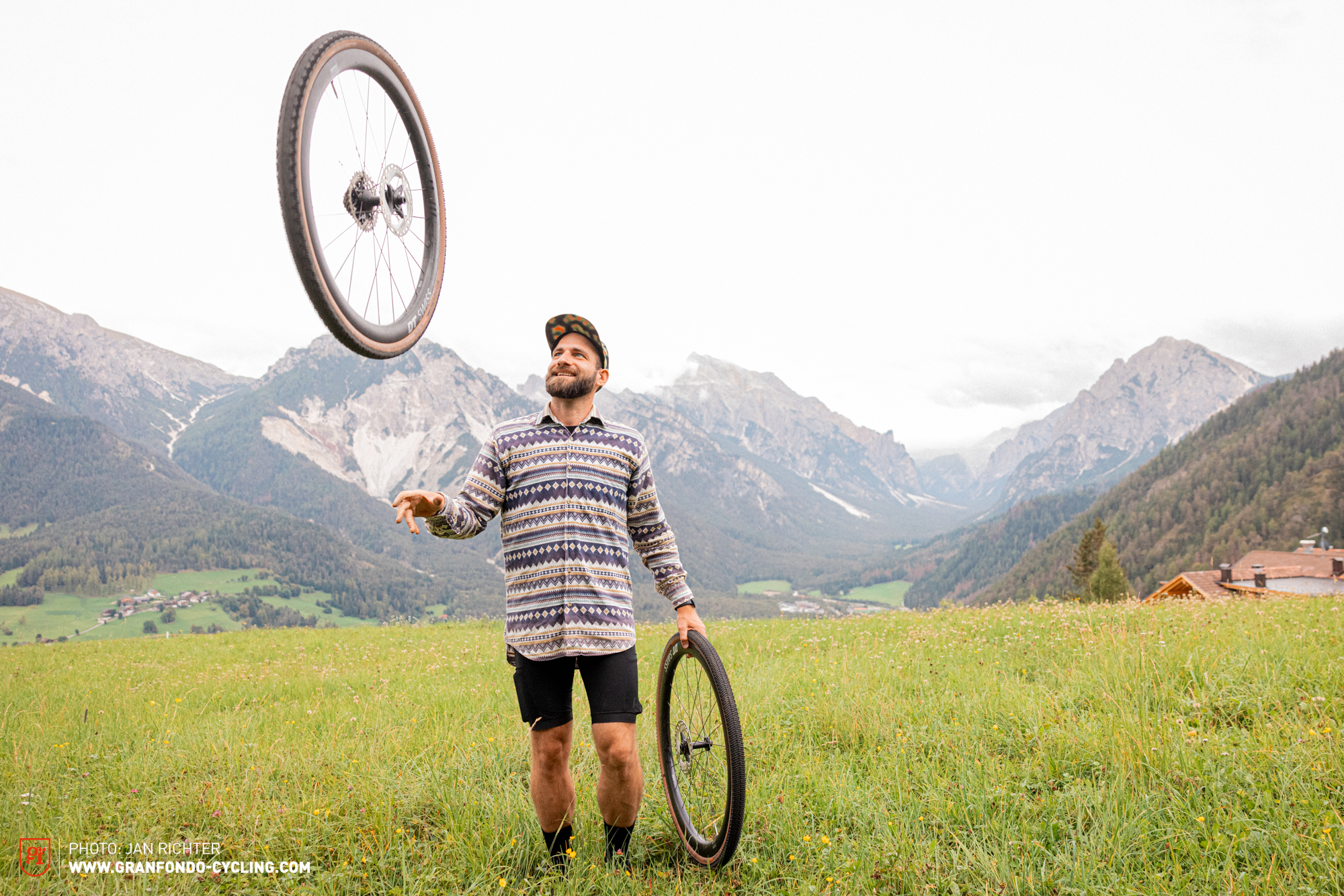
What to consider when choosing the right gravel tires
Unfortunately, choosing the right tires isn’t always as easy as we would like. And the brands often don’t make it any easier for us to choose. They all use different names for the same technologies, rubber compounds, and casings to stand out from the crowd of gravel tires, making things all the more confusing for the end user. Added to that are the limits of different bikes and components. But we’ll tell you everything you should consider, wading through the manufacturer’s specifications and their marketing promises to provide you with the ultimate buyer’s guide to the perfect gravel tires.
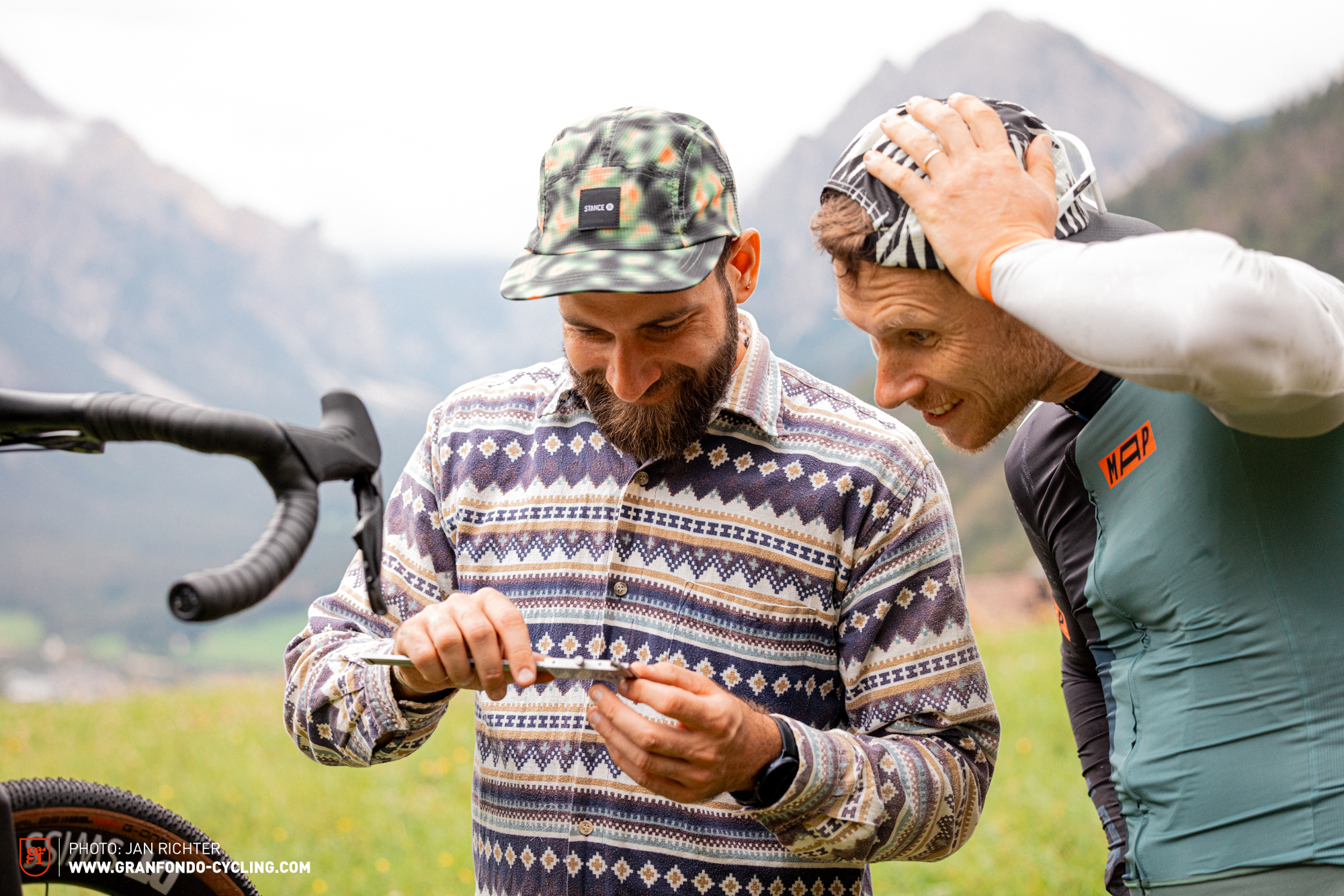
Tire clearance
The first and most important question should be: how wide is my bike’s tire clearance? The maximum tire width differs greatly between bikes – not every gravel bike can accommodate up to 50 mm tires. In addition, the tire width for road and all-road bikes is measured without the tread. Moreover, many tires pack up with mud and clay in wet conditions, which can quickly rub against the frame if you don’t have enough extra clearance. So, if you don’t want to take any risks, stick to the bike’s specs, and if you want to ride UNBOUND Gravel, go two sizes smaller 😉 .
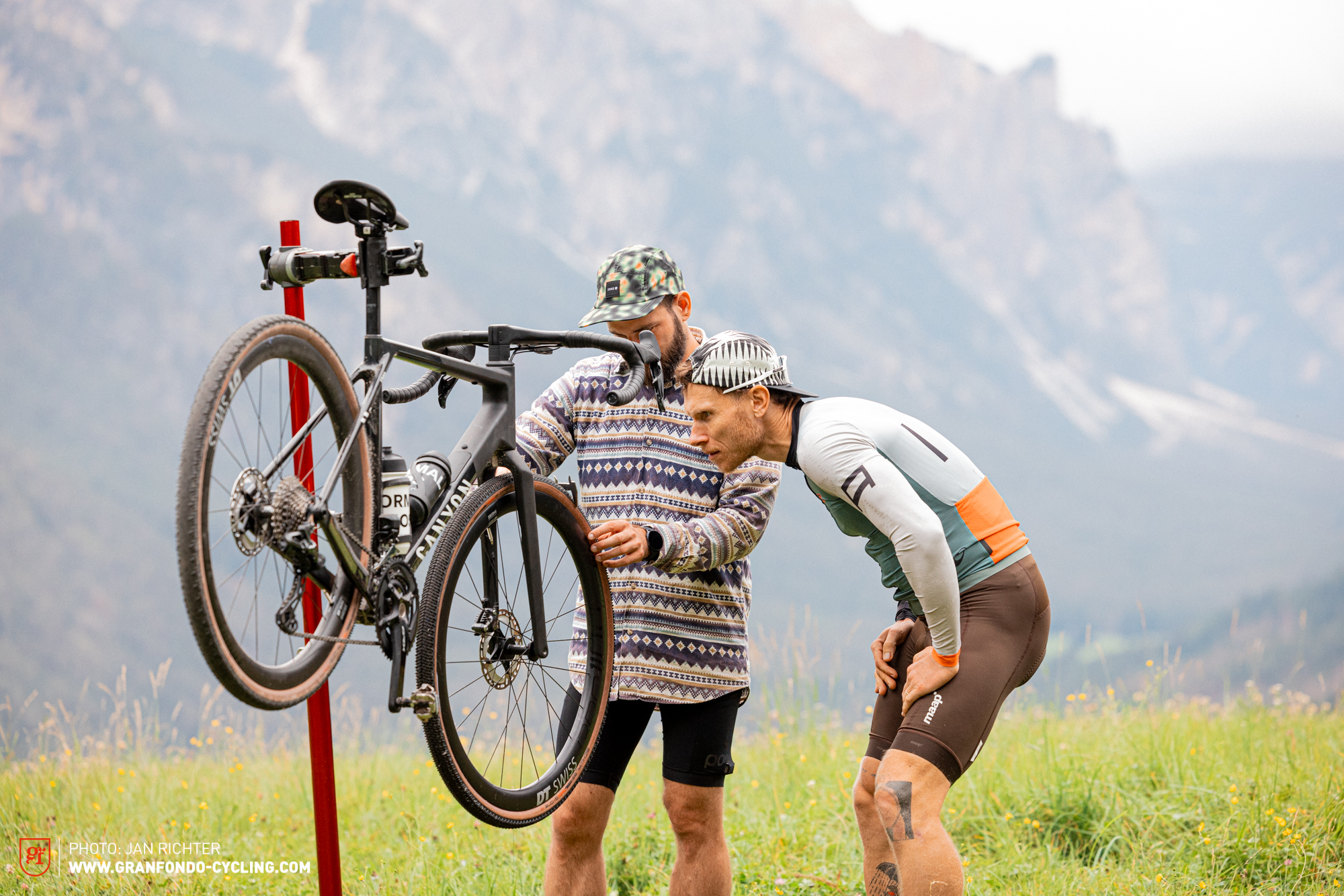
Tire dimensions matching the rim
Tire size
650b, the MTB tire size of past generations, is also no longer relevant on gravel bikes, and has clearly become a niche product. Meanwhile, the 29″ MTB size has become all the rage on gravel bikes. Some manufacturers, like Vittoria, now offer gravel-specific 29″ tires. So the world of MTB tires is now also open on bikes that can accommodate up to 29″ tires. Nevertheless, the 700c road tire size is at the cutting edge of gravel tires and now offers a huge selection for every conceivable gravel riding situation.
Tire width
The tire width directly influences the bike’s comfort, traction, efficiency, weight, and handling. But there’s no such thing as a universally appropriate tire width. On thoroughbred gravel race bikes, an average tire width of 38 mm turned out to be optimal. The tires found on off-road gravel bikes, on the other hand, are significantly wider, often going up to 50 mm.
Wide tires allow you to run lower pressures and are more comfortable than narrower tires. Due to the larger contact patch, more traction can be generated, which lets you corner faster.
Rim width
The rim width determines how wide the tire inflates, and thus directly influences the actual tire width. Skinny tires on wide rims inflate wider than indicated, but they don’t inflate as tall as they would on a narrower rim. It’s not always easy to tell which tire width matches which rim width.
In this case, the specifications of the ETRTO table can help, allowing you to select and check all possible combinations.
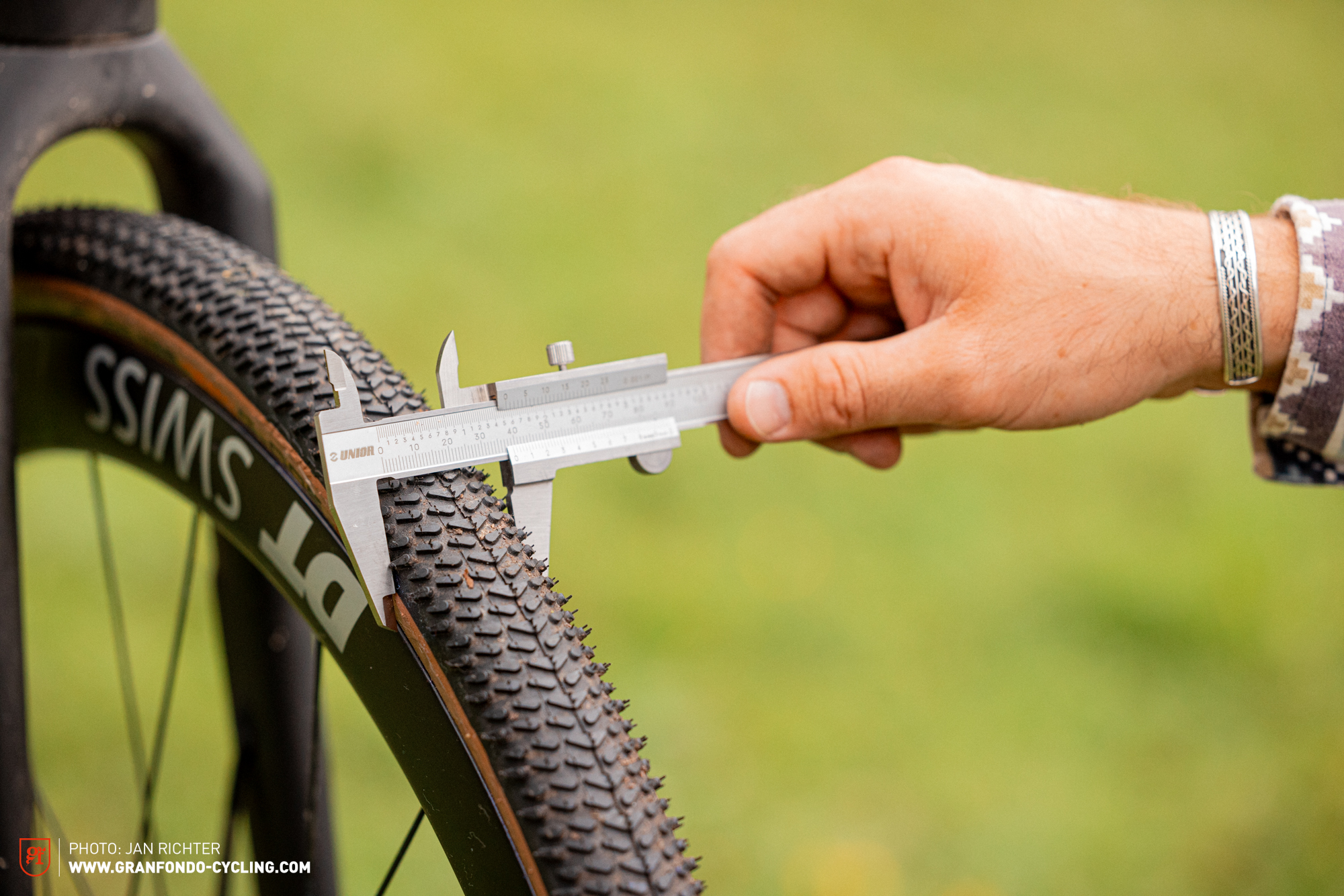

Tread pattern
The tread pattern of the tire is probably the most important point for gravel tires. Like with MTB tires, the tread determines where and how a gravel tire can be used. An extremely grippy and aggressive tread pattern typically provides a lot of off-road traction and confidence, but it’s less efficient than a smooth tread pattern designed for speed. In between, there are tires that aim to strike a balance between speed and traction. This often determines how the tire inflates. A uniform pattern of similar knobs spanning the entire width of the tire results in a predictable tire with consistent cornering grip. A square profile results from much more aggressive shoulder knobs and offers more grip in the corners, but the handling changes depending on how far you lean the bike over. Aggressive shoulder knobs give you more confidence when cornering and they catch the bike when making a sharp turn. On compacted surfaces, however, these tires often feel a little less manoeuvrable than their more rounded counterparts.

Casing
While the casing is absolutely decisive for mountain biking, it’s not yet all that important for gravel riding. Although some brands offer tires with different casings, most gravel tire models only have one casing option. In addition, comparing between brands is difficult due to the different marketing terms used.
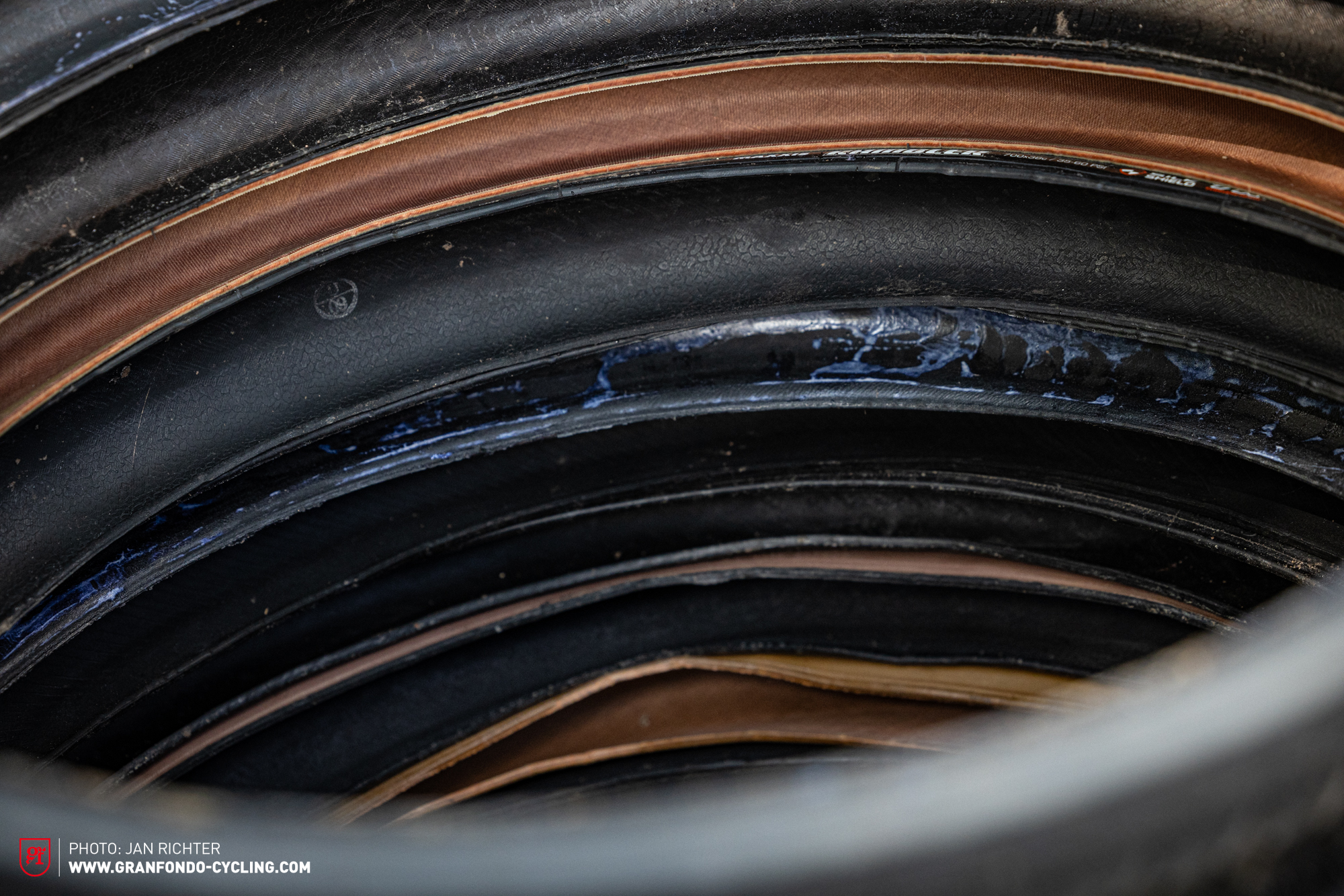
Rubber compound
The same applies here as with the casings: Only few brands offer the same model with different rubber compounds. However, there are significant differences between the brands’ models. Cheaper tires are usually much harder, whereas more expensive models often combine several compounds and are softer.
As far as hardness is concerned, there is a rule of thumb: the harder the tire, the more efficient and durable it is, but at the cost of grip. Softer tires conform to the ground and offer more grip on all surfaces.
However, because the brands’ marketing terms are often meaningless, some tires are difficult to compare. The only way to find how they perform is through trial and error – fortunately, we’ve done that for you!

Puncture protection
Puncture protection on gravel tires is a tricky subject, and not always easy to determine through testing. Even when comparing real world experiences with lab tests and combining that with long-term reviews, we’re not able to make reliable statements about the puncture resistance of 20 tires. We didn’t puncture any of the tires during our tests. And so we must rely entirely on the laboratory values to determine the most puncture-proof tire.
But what determines puncture protection in the first place? Puncture-proof tires have a more robust casing, usually a harder rubber compound, and they’re often just thicker, which makes it harder to puncture the tire. However, this also means that more puncture-resistant tires are usually heavier and more inefficient than those that don’t resist punctures so well.
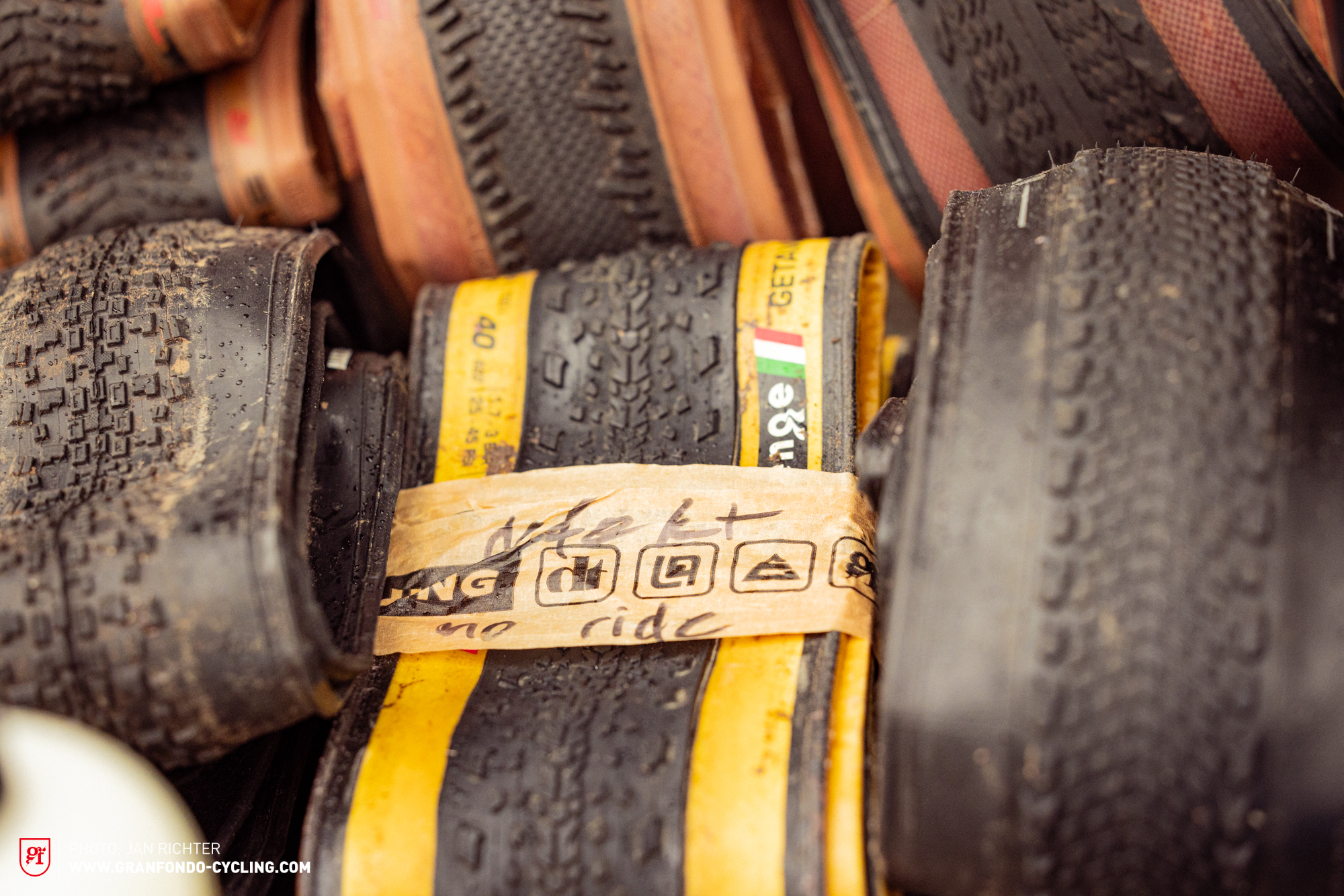
Tubeless / tube
Tubes in a gravel bike? Who still does that? Going tubeless offers less rolling resistance and more puncture protection. At the same time, being able to run lower pressures offers more traction. Gravel bikes must be set up tubeless. Period.
Fortunately, all the tires on test are tubeless ready. While some need a little more persuasion, they ultimately all sealed.
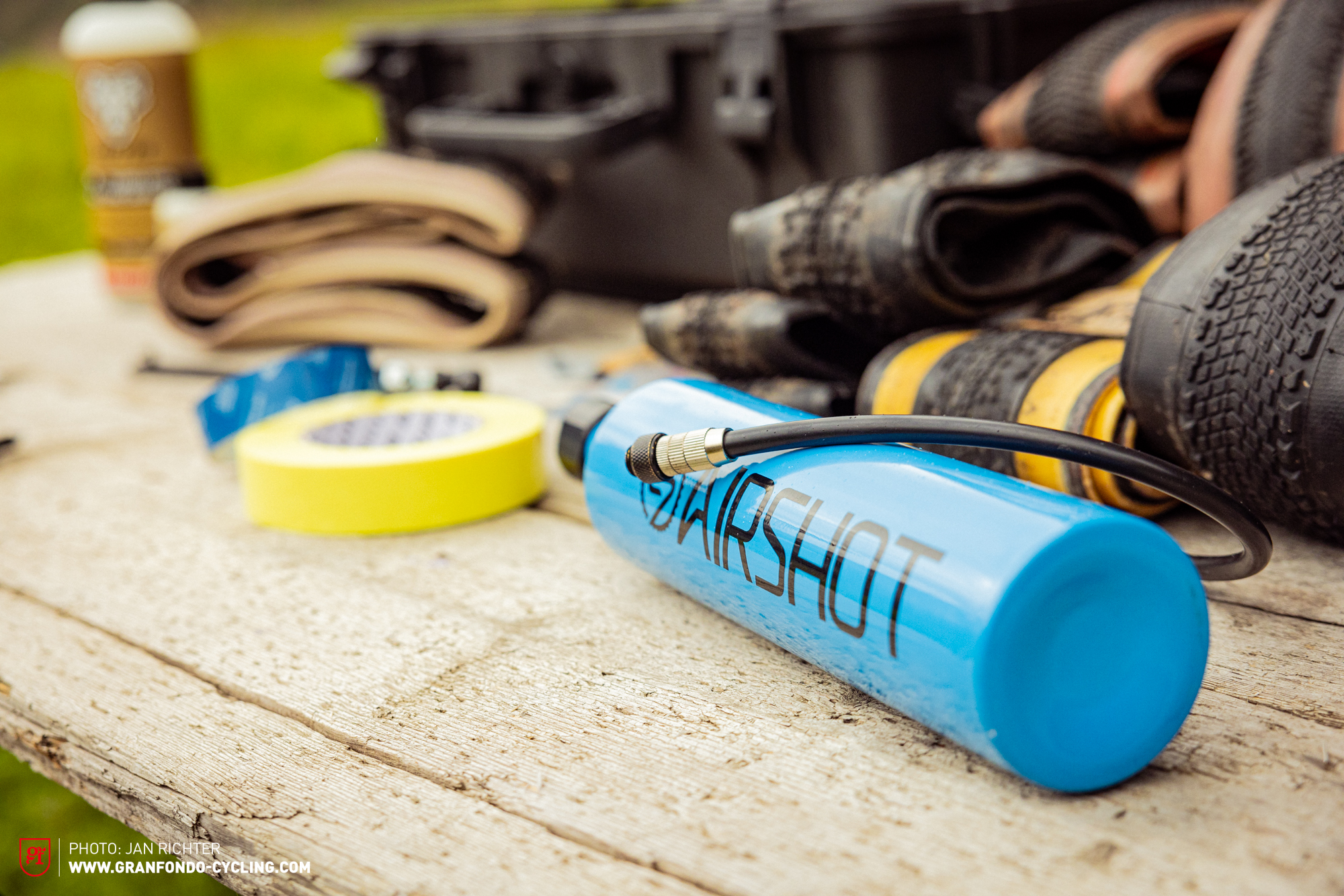
Installation
Even if tubeless tires are indispensable on gravel bikes, installing them is much more demanding than with a tube. But with the right rim and properly installed tubeless tape, the tires should all seal relatively easily. Tubeless tires tend to fit a little tighter, which can make them difficult to mount without the appropriate tools. However, we were able to fit all tires on test with a pair of sturdy tire levers. A little tip: A compressor or a special tubeless pump works wonders and makes the installation much easier. The choice of tubeless sealant is crucial, too. Our tests have shown that liquid sealant usually works better than the more viscous stuff.

Tire pressure
The optimal tire pressure is a complicated compromise between traction, comfort, and efficiency. And a matter of personal preference. We all like to think of our ideal tire pressure as the ideal tire pressure for all scenarios and riders, but it’s a very individual and personal question that depends on the terrain and riding style, preferences, and not least the tire width. The tire pressures specified on the tires of the test field reflect the normal range that riders usually prefer, though Vittoria indicate a maximum pressure of 6 bar, which is far from typical gravel tire pressures. The remaining brands usually settle at a maximum of 4 bar, with Challenge specifying a maximum of just 3 bar. Some manufacturers also indicate a minimum tire pressure. However, a minimum of 2.5 bar goes against typical gravel tire pressures, which often fall well below that.
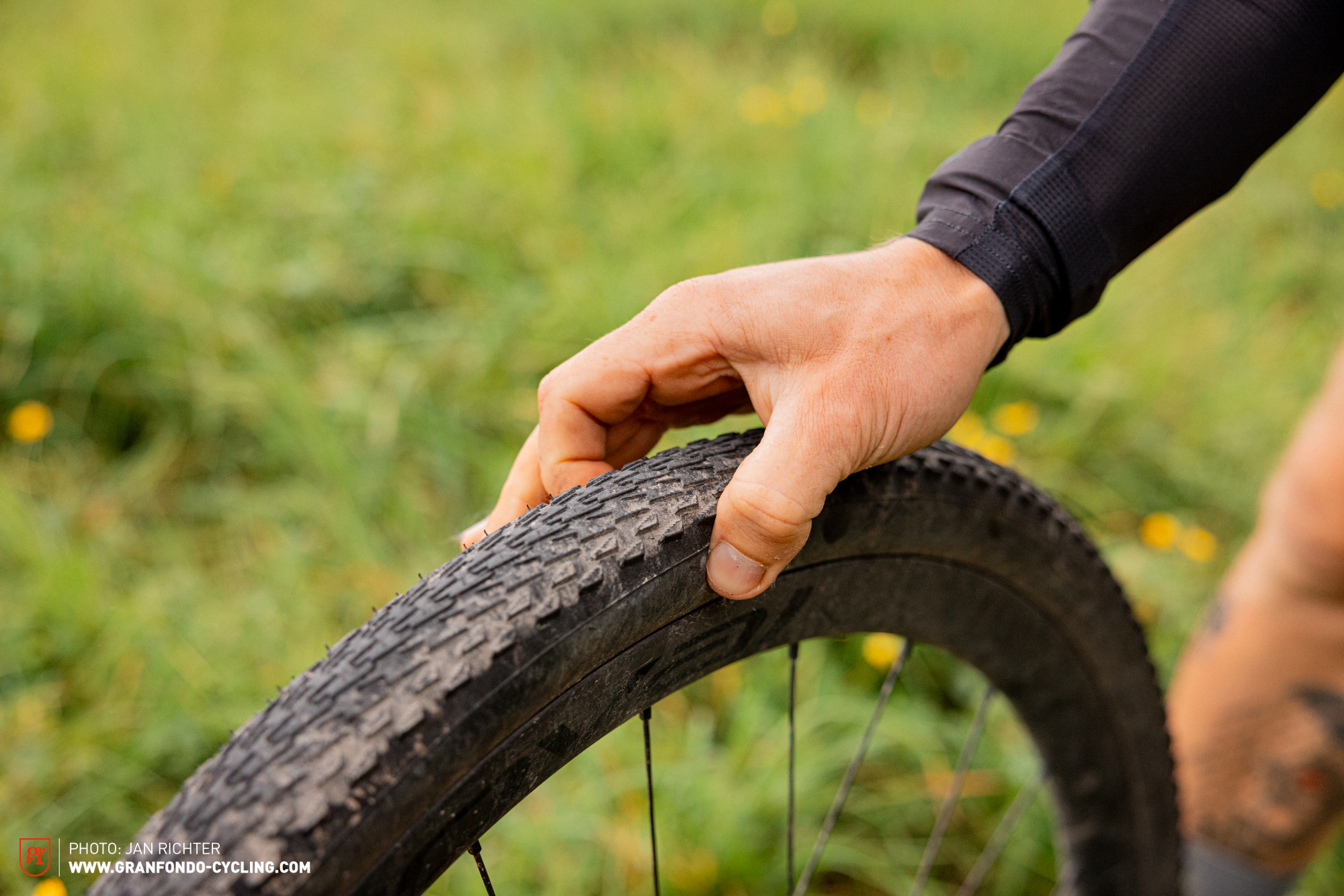
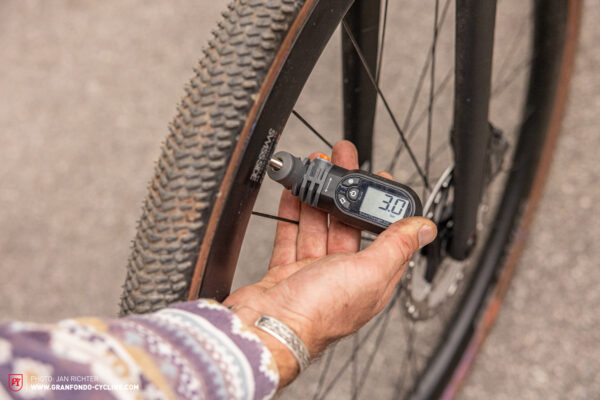
Front tires ≠ rear tires
To mountain bikers, this is common knowledge, but it’s a good idea to have different tires at the front and rear, especially when going off-road. This is due to the fundamentally different requirements of the front and rear tires. On the front wheel, you need significantly more traction and cornering grip for confidence and control when riding off-road. At the rear, however, rolling efficiency plays a more important role because it can save you valuable watts. And a rear wheel skid is easier to control and less scary than sliding out at the front. That said, a grippy front tire and a fast rolling rear tire isn’t the go-to combination for all scenarios. Sometimes, you’ll also need a grippy rear tire, simply to avoid spinning out in slippery terrain.

Who tested, and how?
We subjected 20 tires to the ultimate test, raced them through the Black Forest, and examined them in a laboratory. But what really matters, and how important are the individual reviews?
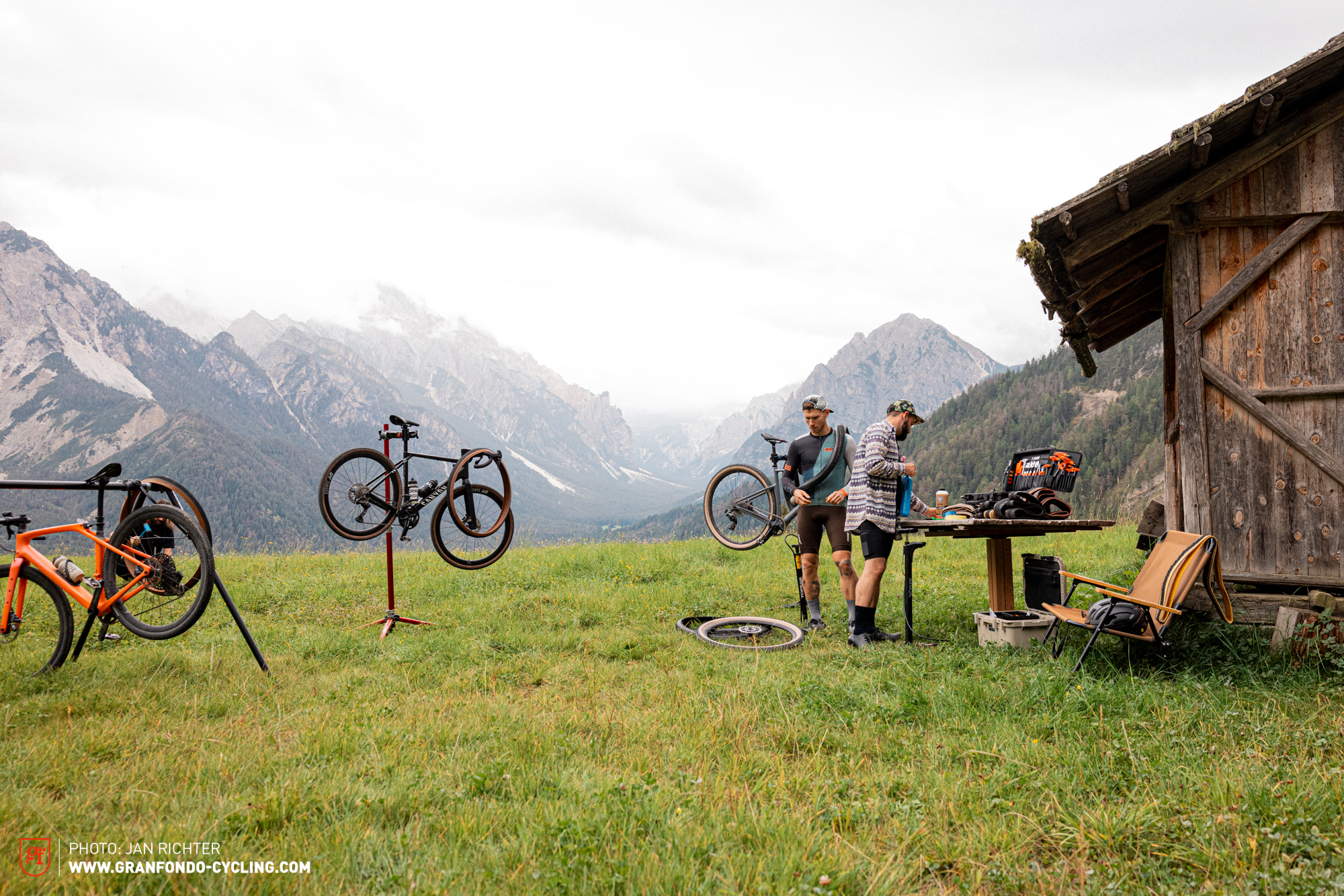
Real-world tests
Probably the most demanding group test in GRAN FONDO history: we fitted over 60 tires to brand-new DT Swiss G 1800 spline rims, and tested them on our favourite gravel race and gravity-gravel bikes, climbing steep climbs and racing down fast descent on our test track. We tested them on every conceivable terrain, swung ourselves onto the bikes in the blistering heat and in the pouring rain. We also integrated some technical sections into the route.
But what do we look for in a real world test? Sure, the first impression counts: how do the tires ride on different surfaces? How much traction and cornering grip do they provide? How much compliance do the tires offer, and how efficiently do they roll? And of course, what do the tires look like, and what do they smell like? Yes, you read that right, we actually tested the tires’ smell. To our surprise, there are big differences, and we’ll tell you which tire we think smells the best.
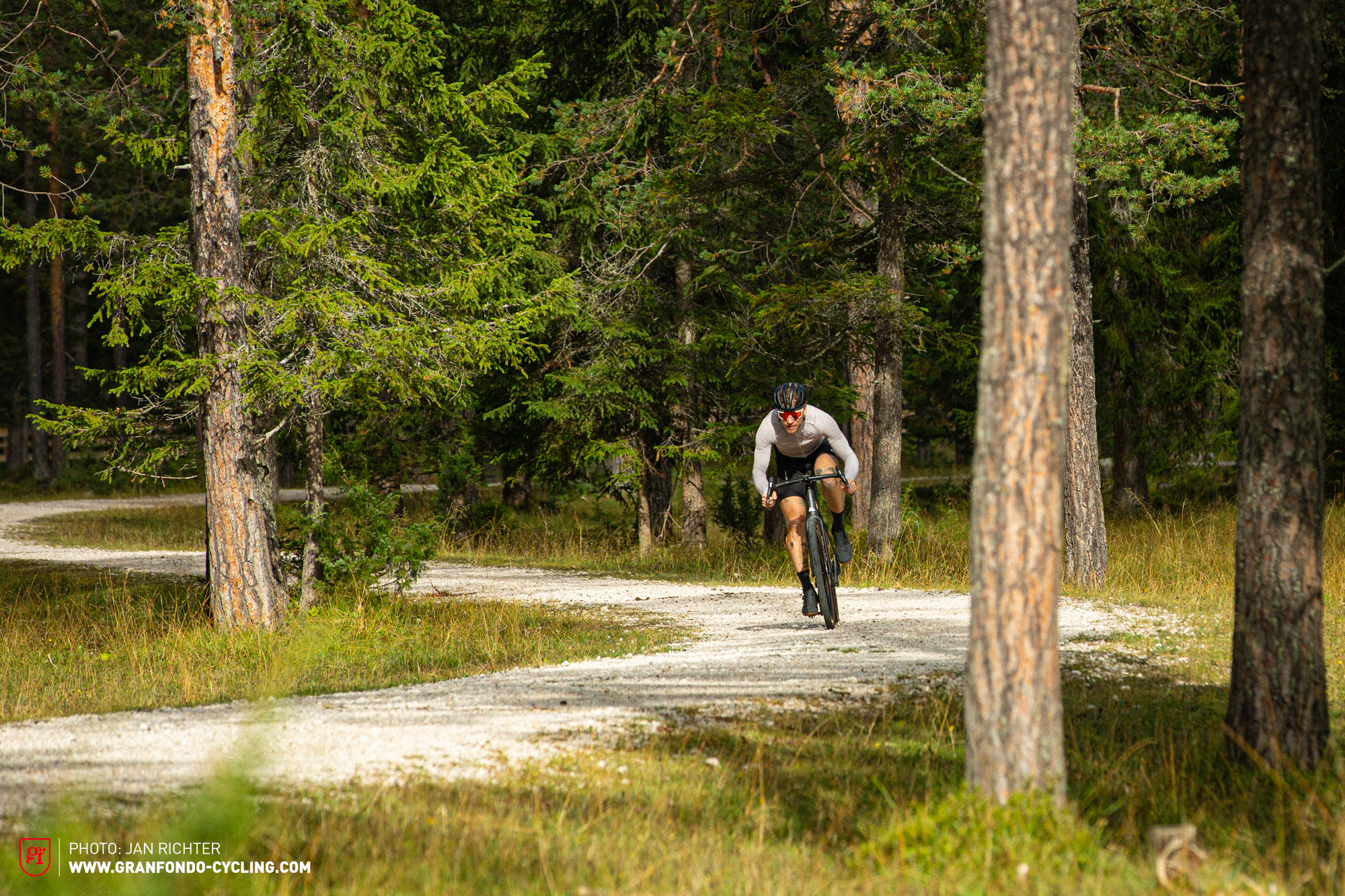
Laboratory tests
We visited Schwalbe’s in-house laboratory and put the tires through their paces to find out what’s behind their rubber facade. The standardised tests for rolling efficiency, as well as pinch and puncture resistance provide good reference points, allowing us to make direct comparisons. Nevertheless, they remain laboratory values, and don’t necessarily reflect the tires’ performance on your local trail or distant gravel roads. It’s difficult to replicate real-world conditions in the laboratory, especially with conditions as wide ranging as you’ll encounter with gravel riding.
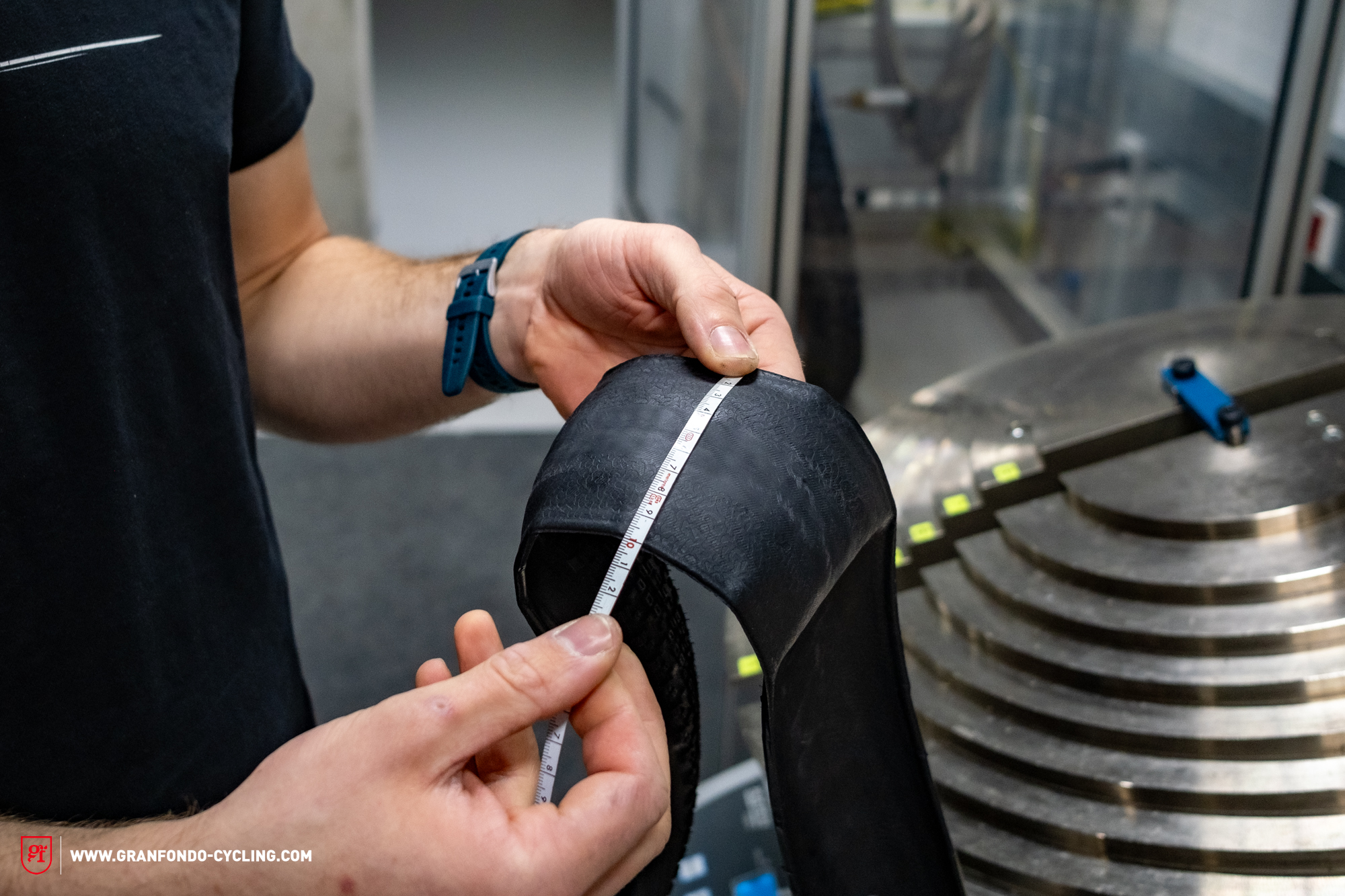
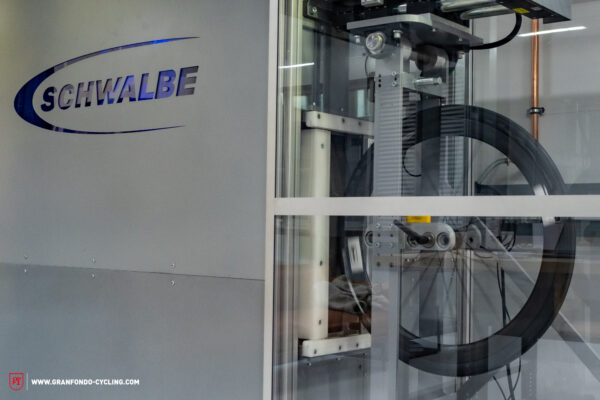

The highlights of our big 2023 gravel tire group test
Speed-gravel
For the speed gravel tires, we had just one priority. You won’t find any compromises or trail performance here because these tires are all about speed and nothing but speed. Whether it’s road, hardpack, asphalt or gravel, these models are unbeatable.

- Challenge Gravel Grinder
- Continental Terra Speed
- MAXXIS Receptor
- Panaracer GravelKing SK+
- Pirelli Cinturato Gravel H
- Schwalbe G-One RS
- Specialized S-Works Pathfinder
Efficiency is clearly prioritised here, and you can see that when looking at the tires. The shallow tread and smooth centre strip don’t just make these the ideal choice for speed freaks, but some of them also perform brilliantly as rear tires only. Our speed king is the Schwalbe G-One RS: With just 12 watts of rolling resistance, it is the fastest tire in the test field, and also offers lots of grip off-road thanks to the aggressive shoulder knobs.
All-round
Just average at everything or true all-rounders? Although these tires are called all-rounders, they are not all the same. Here, too, they run the gamut from tires that can almost compete with the speed category in terms of efficiency, to absolute traction monsters. That said, the all-rounders can’t really compete with the respective specialist in their field, though they do perform excellently in almost all situations. Our all-rounders offer a good compromise between efficiency, traction, and comfort on all surfaces.
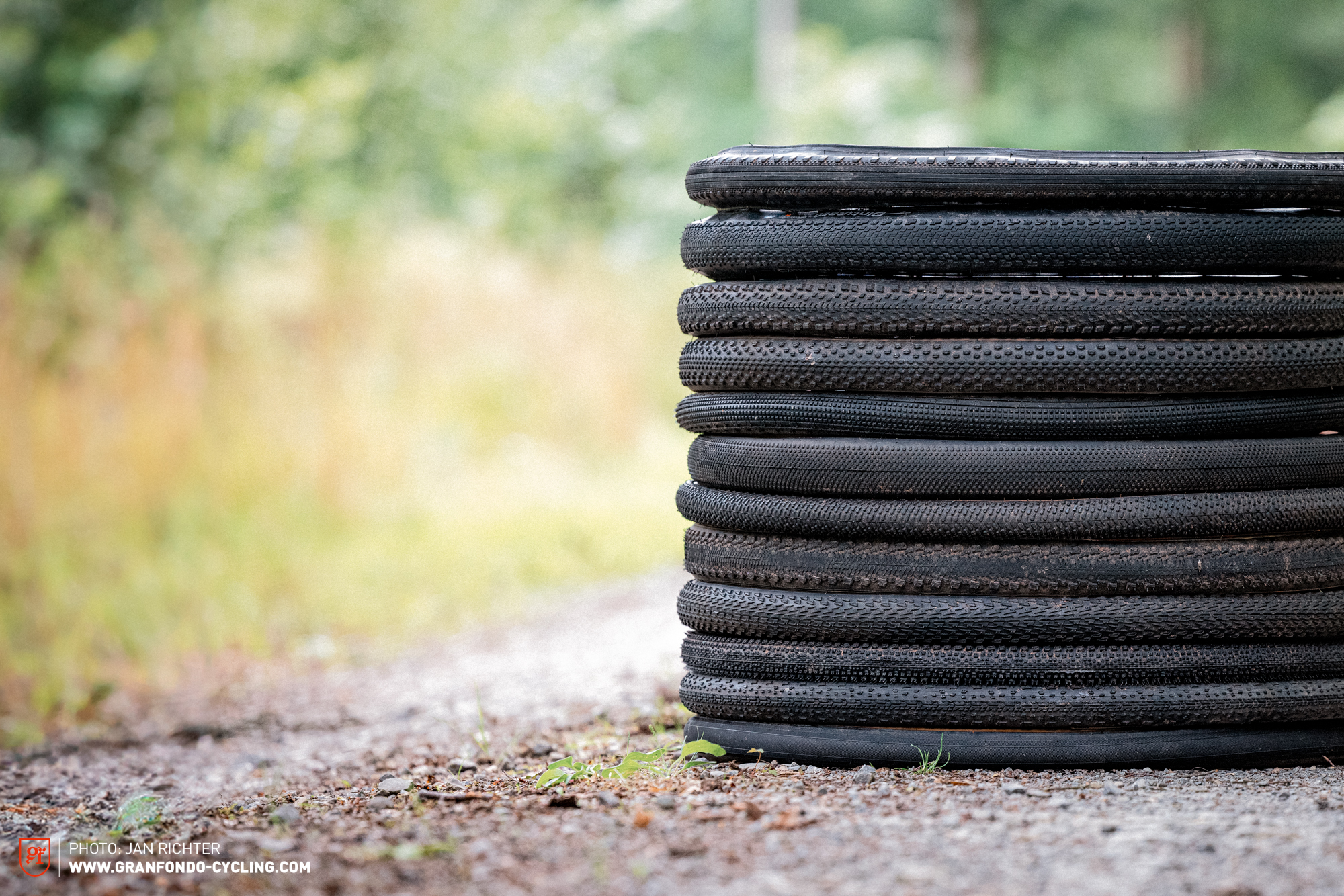
- Challenge Getaway
- Continental Terra Trail
- Panaracer GravelKing Knobby
- Panaracer GravelKing Slick Plus+
- Pinarello Cinturato Gravel H
- Pinarello Cinturato Gravel RC
- Schwalbe G-One Allround
- Schwalbe G-One R
- Specialized S-Works Tracer
- Vittoria Terreno Dry
- WTB Riddler
- WTB Byway
All-rounders are the best choice for those who don’t want to commit, preferring to keep all their options open. Fast bike paths and high-speed trail descents? No problem for all-rounders. We recommend the Continental Terra Trail and the Specialized S-Works Tracer due to their surprising grippiness despite rolling relatively efficiently.
High traction
Is it a mountain bike or a drop bar bike? You’d be forgiven for asking that with the absolute grip monsters in this category. These tires are mainly used on loamy forest floors and loose surfaces, outshining the competition on the trails. The ideal trail tire doesn’t necessarily have to excel on gravel. In this category, the rolling efficiency measured in the lab is secondary. When descending on trail, a grippy tread pattern and a soft rubber compound are worth their weight in gold. This is where they leave competition behind. The MAXXIS Rambler gets our recommendation. Even if the tread pattern isn’t the most aggressive, this tire can outperform all others in terms of traction, deserving the title of the grippiest tire on test.
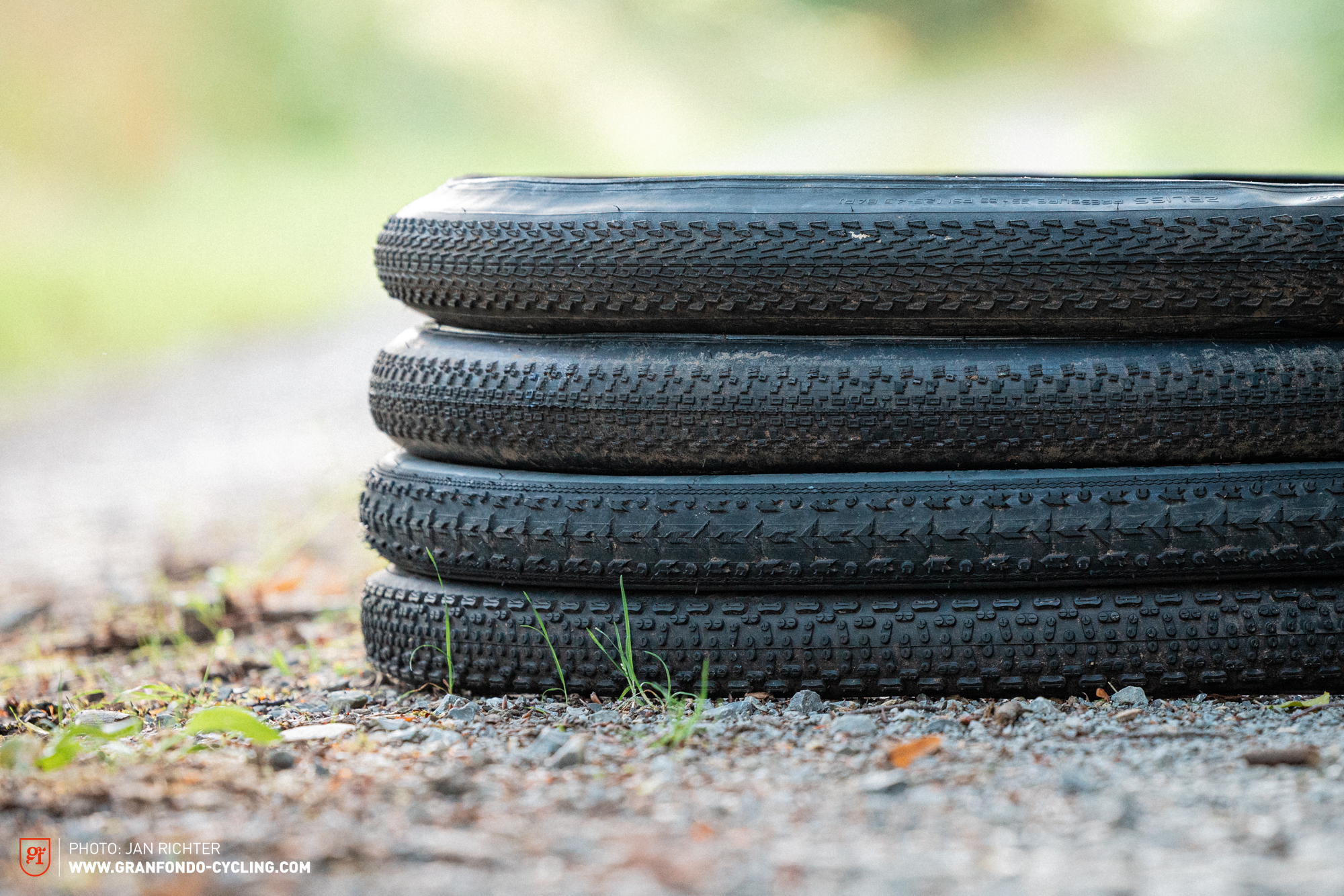
- MAXXIS Rambler
- Schwalbe G-One Ultrabite
- Specialized S-Works Tracer
- Vittoria Terreno Mix
Carefree tires
Our carefree tires weren’t chosen in advance, but simply proved to be particularly durable during the course of the test. They can and will take a beating. Note: looks can be deceiving! It’s not the most aggressive looking and fattest tires that made it into this category.
The tires from Panaracer turned out to be the most puncture resistant in the lab, specifically the GravelKing SK+, offered the most pinch protection and fared equally well in the puncture test. The GravelKing+ tires were confidence-inspiring too. Schwalbe’s G-One R & RS tires also performed above average in terms of robustness, which is impressive considering their low weight and high efficiency.
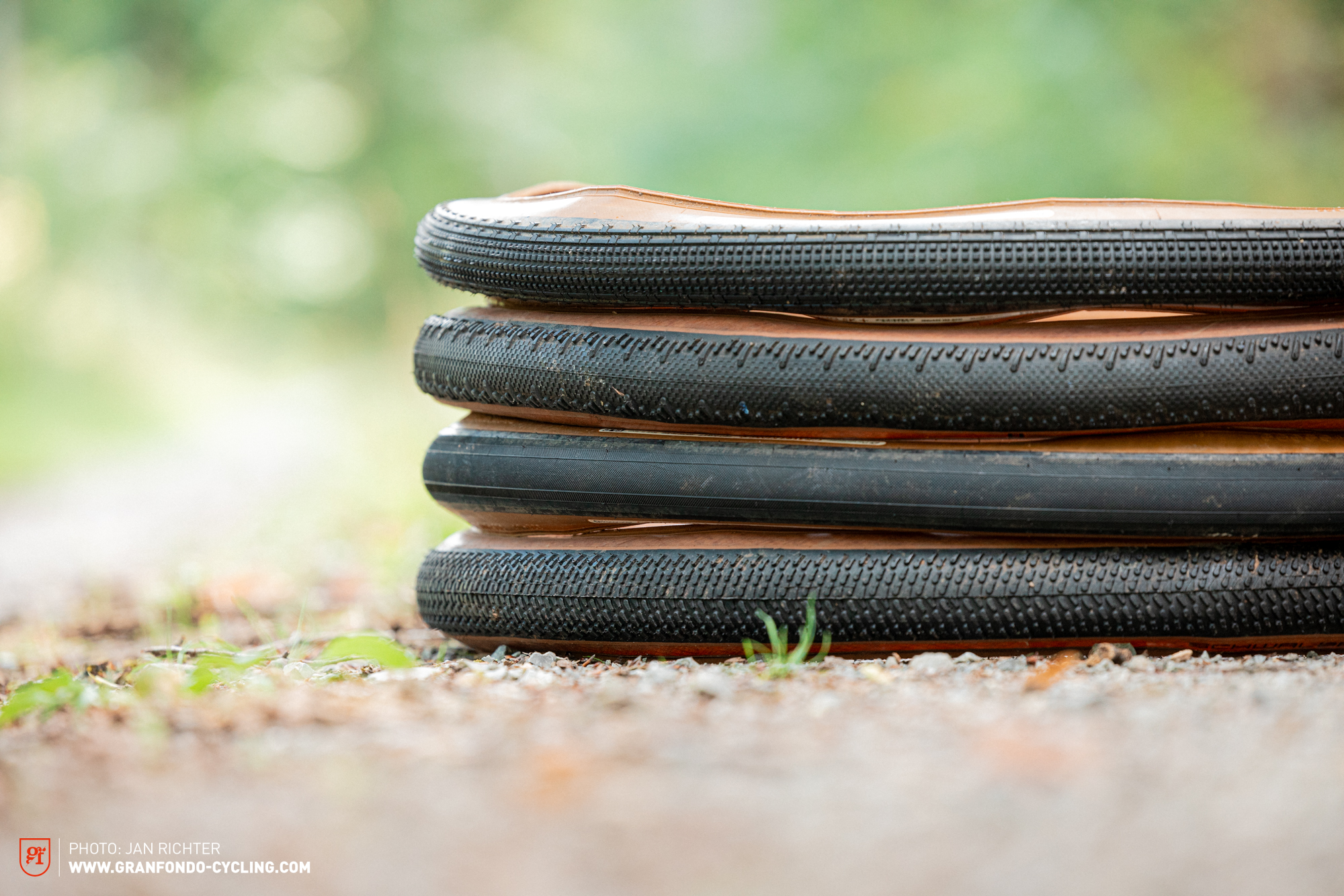
- Panaracer GravelKing SK+
- Schwalbe G-One RS
- Panaracer GravelKing+
- Schwalbe G-One R
Insights – How do you get the most out of your tires?
Looks can be deceiving
The look of the tires has a direct influence on your perception, occasionally giving a false impression of their capabilities. For example, fast looking tires like the Vittoria Terreno Dry aren’t always that fast, and very knobby tires like the Schwalbe G-One Ultrabite look like the ultimate mud tire, but they quickly pack up with mud and mutate into slicks.
Fit: Easy-peasy vs a feat of strength
Fitting the tires either works or it doesn’t. Some go on super easy without any tools and inflate on the first try, others are very difficult to fit or don’t seal. Here, the tires from Challenge and Pirelli proved to be particularly troublesome. Challenge tires need a lot of persuasion and sturdy tire levers to get on the rim, whereas the models from Pirelli prefer a little more sealant to properly seal the tire.
Light ≠ fast
Less weight doesn’t automatically result in a fast tire, and it plays a rather minor role in most situations. A more efficient rolling tire makes up for the difference in weight in most situations. 10 watts less is often worth more than a 100 g weight saving.
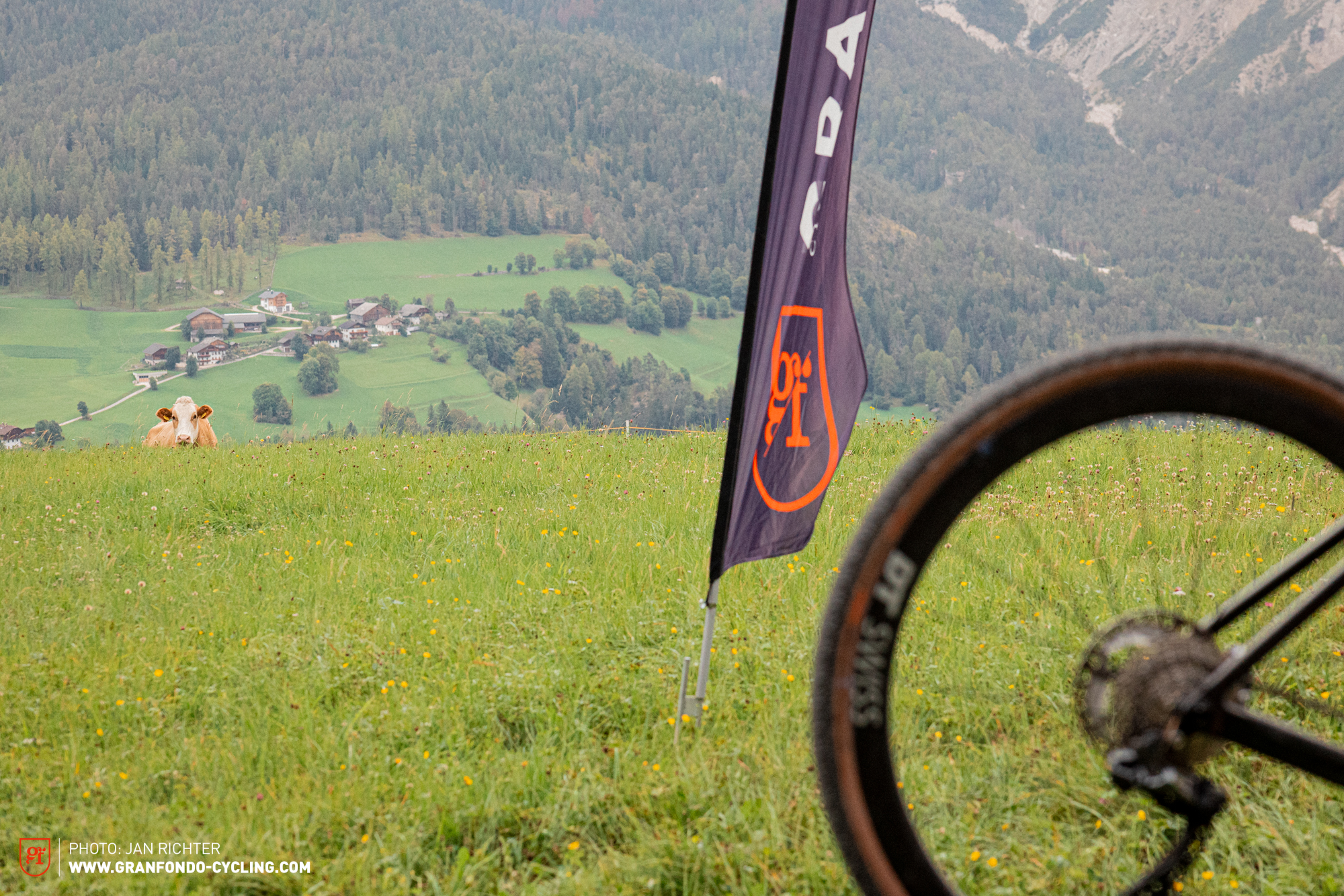
Gravel ≠ gravel
Not all gravel is the same. That sounds trivial at first, but it’s surprising how big the differences between the tires actually are. The tires are often worlds apart, even within the same category. That’s good, because it means you can find the perfect tires for your specific needs.
Tan-wall ≠ tan-wall
Tan-walls are back and they’re here to stay. However, retro looking tan sidewalls aren’t all made equal – there’s a clear distinction between real and faux tan. Challenge offer the most beautiful tires in the test field, especially because of the naturally tan sidewalls. They reveal the natural colour of the fibres instead of covering them in black rubber. While this saves weight, it also means the sidewalls are less robust. Other manufacturers like Vittoria, WTB, and Schwalbe imitate the tan-wall look with coloured sidewalls, which doesn’t always look that nice. Ultimately, it must suit the bike, perform well, and appeal to your individual taste.
Front tires ≠ rear tires
What’s long been standard on mountain bikes should also become a lot more common in the gravel sector. The different requirements of the front and rear wheels require different tires, and that’s how you should set up your bike. Our favourite combinations are the Schwalbe G-One R & RS, and the Challenge Getaway & Gravel Grinder. And, like on a mountain bike, the grippy tire goes on the front, while the fast rolling tire belongs on the rear!
Tops
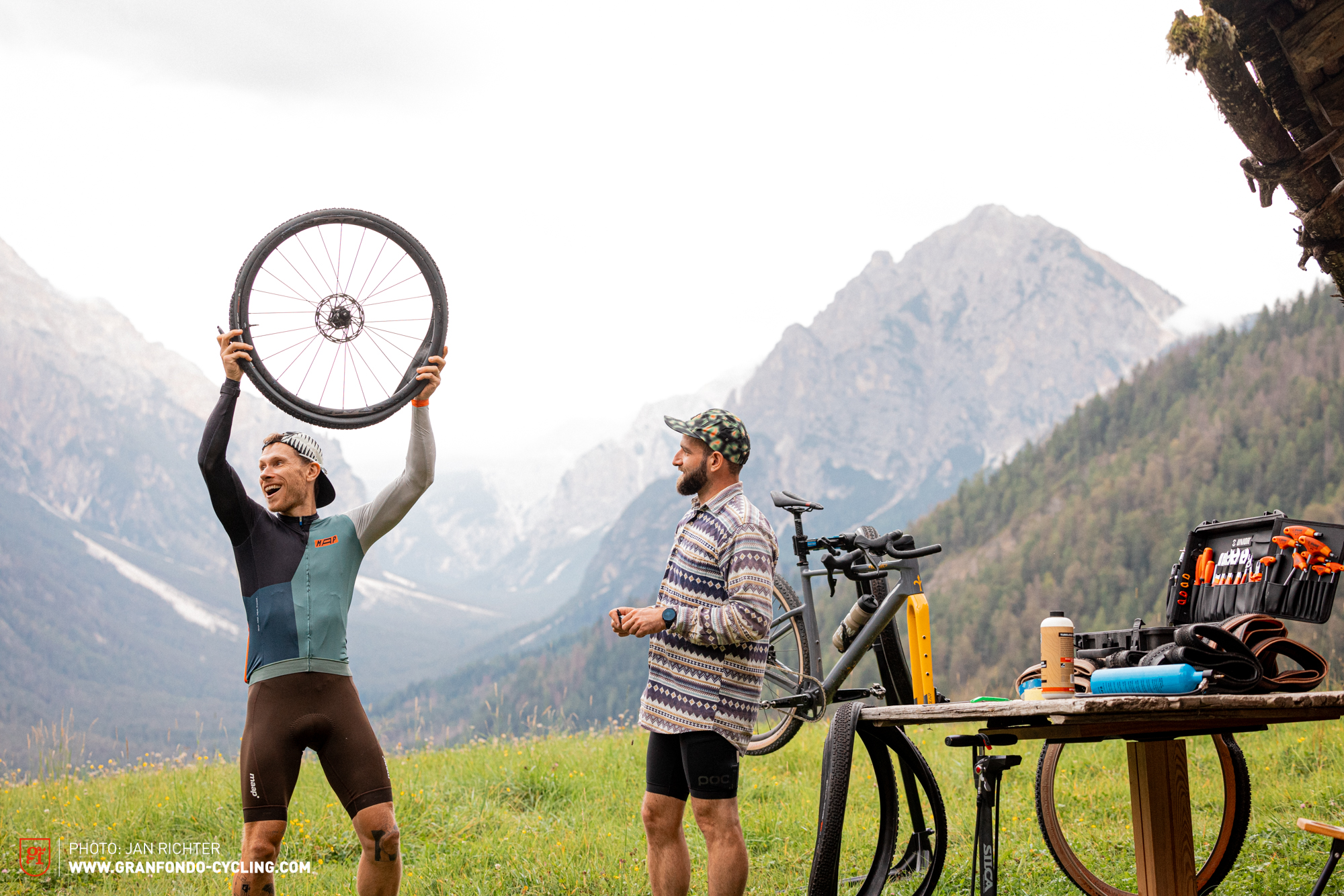
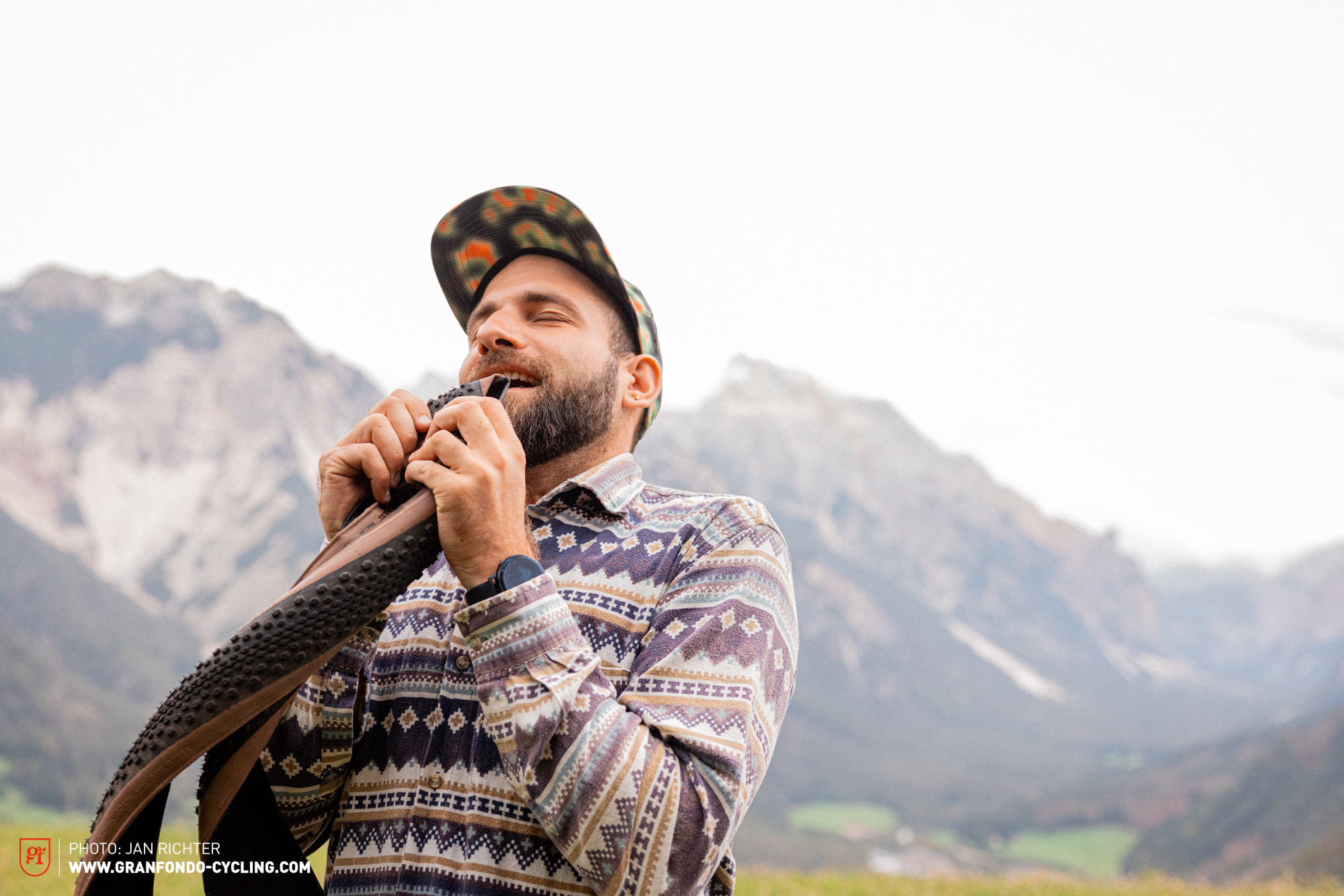
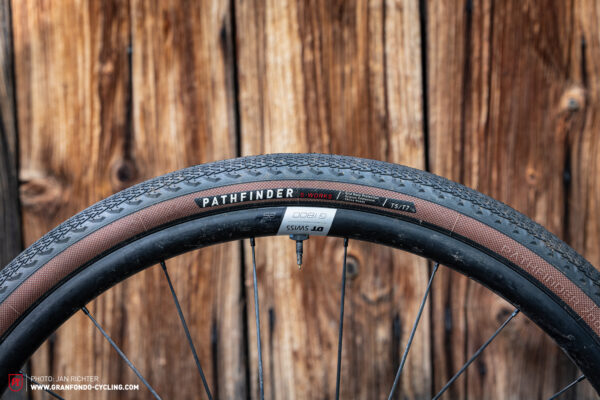
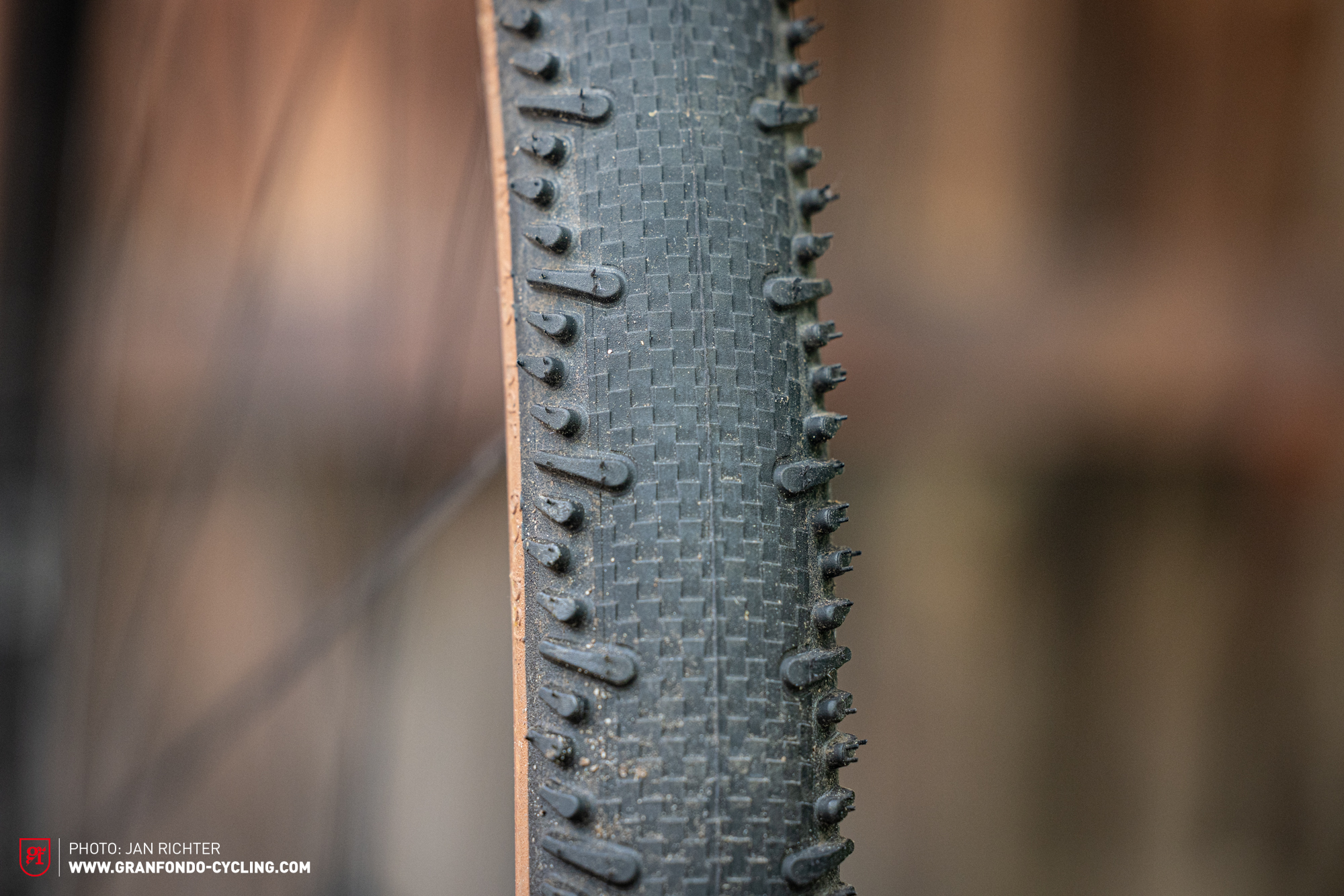
Flops

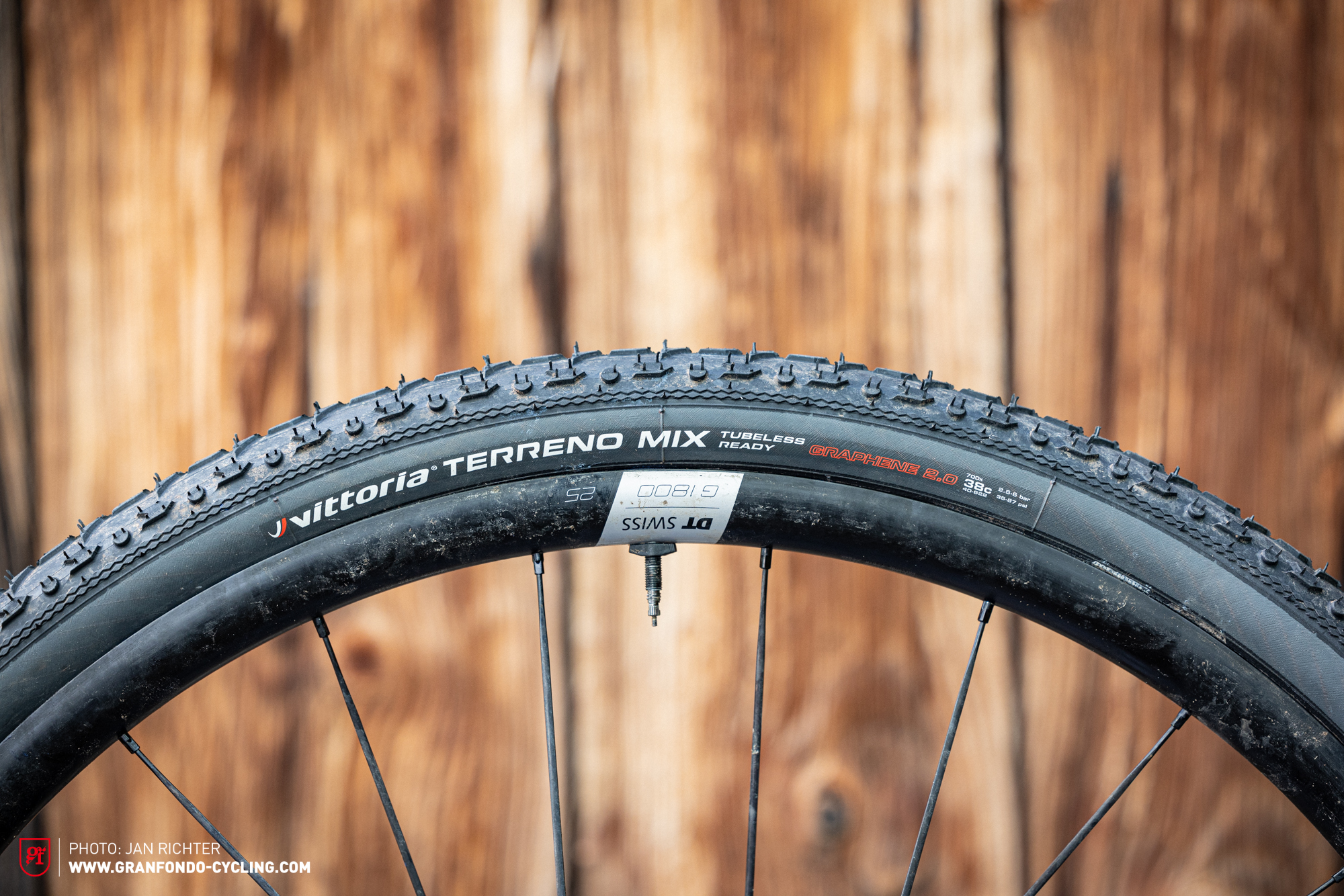
Conclusion
Gravel tires are as versatile as the use cases themselves, and this is also reflected in our group test. And while this makes it more difficult to choose the right tires, it also means you can find the perfect tires for all types of riders and conditions. And so we haven’t selected one best in test, best all-round tire, or the fastest tire under all circumstances. Instead, by dividing the tires into different categories we wanted to make it easier for you to compare the models and ultimately find the perfect tires for your needs.
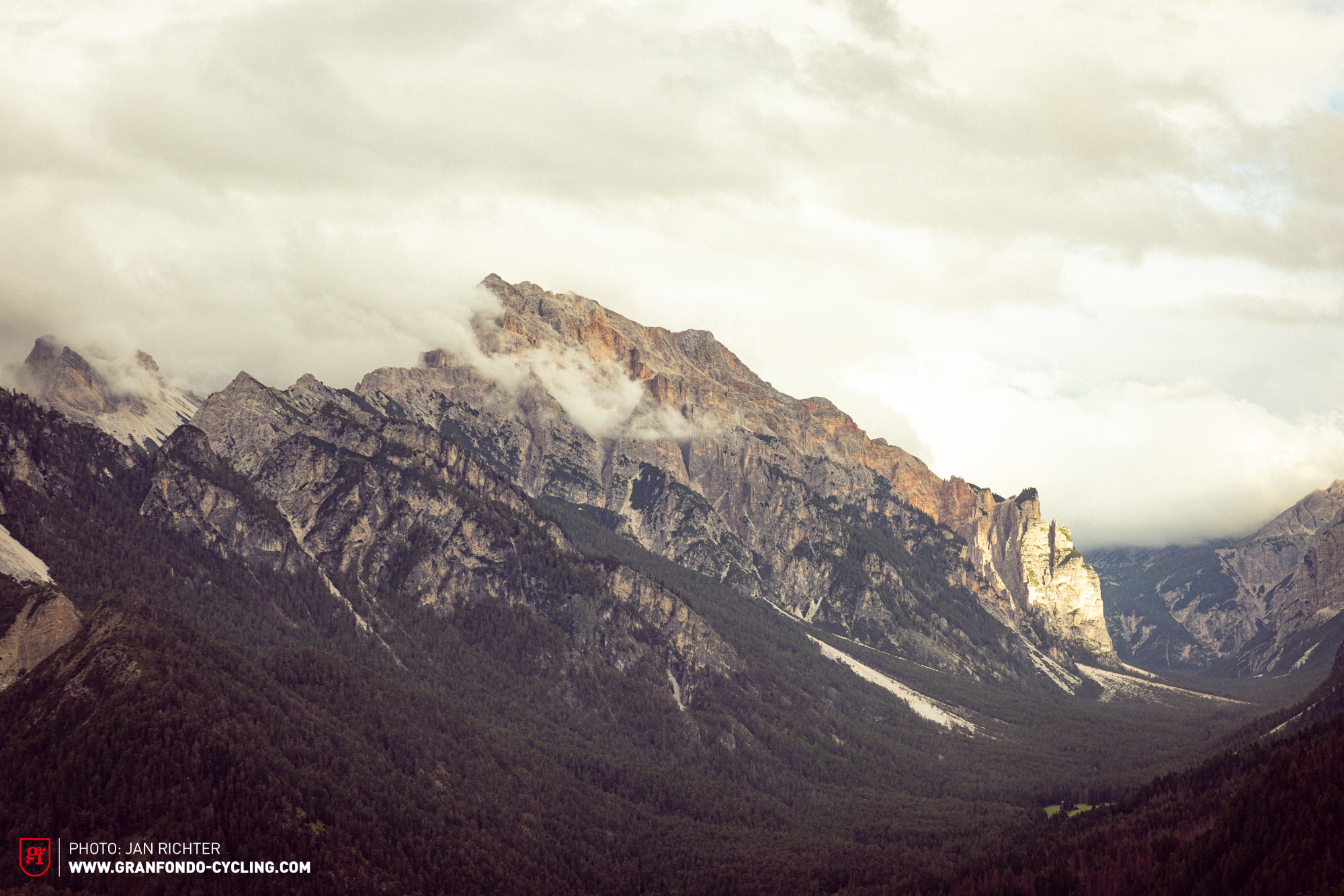
Did you enjoy this article? If so, we would be stoked if you decide to support us with a monthly contribution. By becoming a supporter of GRAN FONDO, you will help secure a sustainable future for high-quality cycling journalism. Click here to learn more.
Words: Calvin Zajac Photos: Jan Richter, Simon Kohler







